Why wick African Violet plants?
- The number one answer to this question would be to save time, especially if you have over 20 plants.
- The second answer would be, African Violets on wicks grow faster in my personal experience.
- Wick watering (or wicking) provides African Violets with consistent water, humidity and fertilizer.
- Many times African Violet plants fail to thrive due to under or over watering, whereas wick watering can provide an evenly moist environment potentially solving this problem.
- Wick watering also avoids the problem of wetting the leaves of the African violet plant (which usually occurs when top watering the plant) as it provides the correct amount of water required by the plant from below the pot.
What is wick watering?
- Wick watering (or wicking or wick irrigation) is a watering method for African Violet plants providing consistent water when needed by the plant.
- Wick watering can also act as a means to supply fertilizer and create humidity for African Violet plants.
- Wick watering involves a wick that is threaded through the bottom of a pot to the top. The bottom of the wick sits in another container or reservoir containing water below the pot or on a moist capillary mat
- Through the wick, water is absorbed from the reservoir/capillary mat and transported to the pot where is it distributed through the soil and absorbed (i.e. the soil is moistened and the plant watered).
Below are some items which can be useful while wick watering African Violet plants:
How to wick African Violet plants?
- First of all, if you have a number of plants, then try out wicking on 2-3 plants first and then convert all your plants to this system if it works for you.
- An African violet wicking kit (or wick system) can be found at a local garden supply store or ordered online from Ebay or gardening suppliers. Individual African Violet wicking supplies can also be bought from a store or online instead of purchasing the whole system.
- Another easier alternative is to make your own African Violet wicking system.
- As seen in the picture below, these are the major supplies required for a homemade African Violet wicking system: (this example is for a 3 inch pot in height and 3”in diameter).
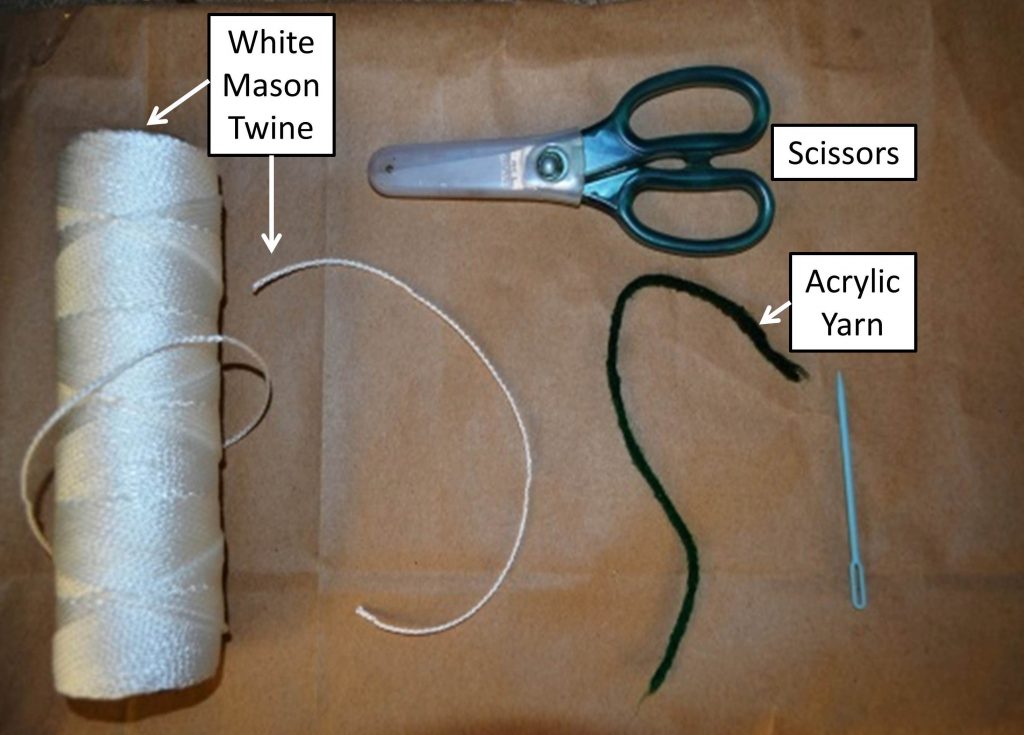
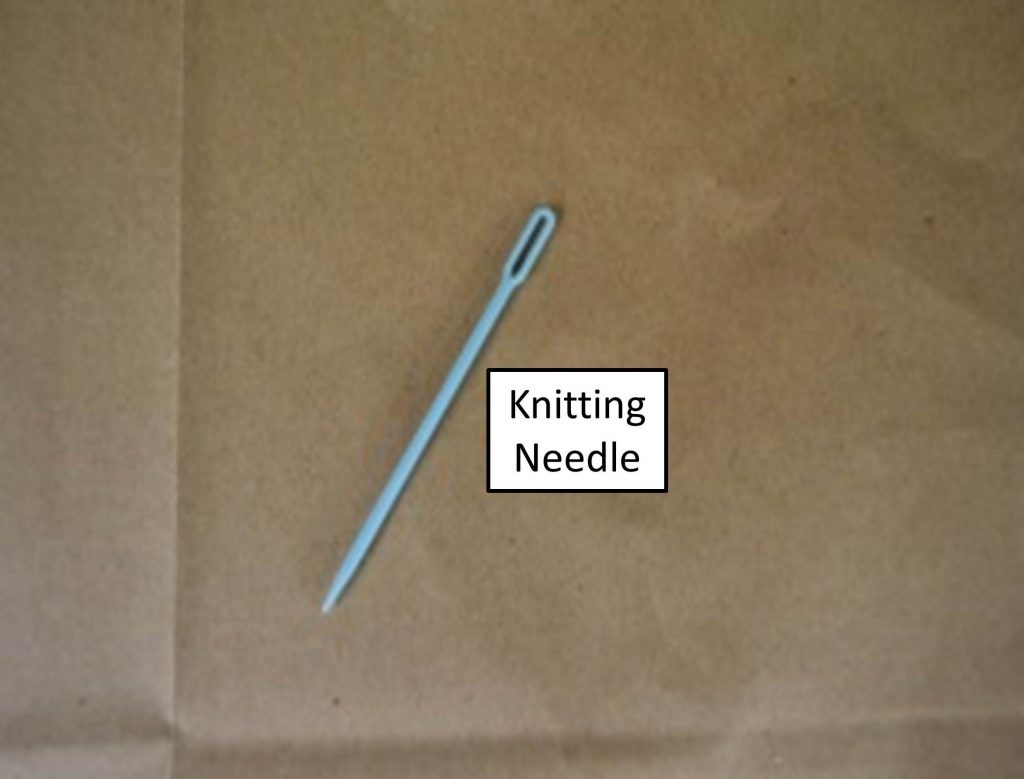
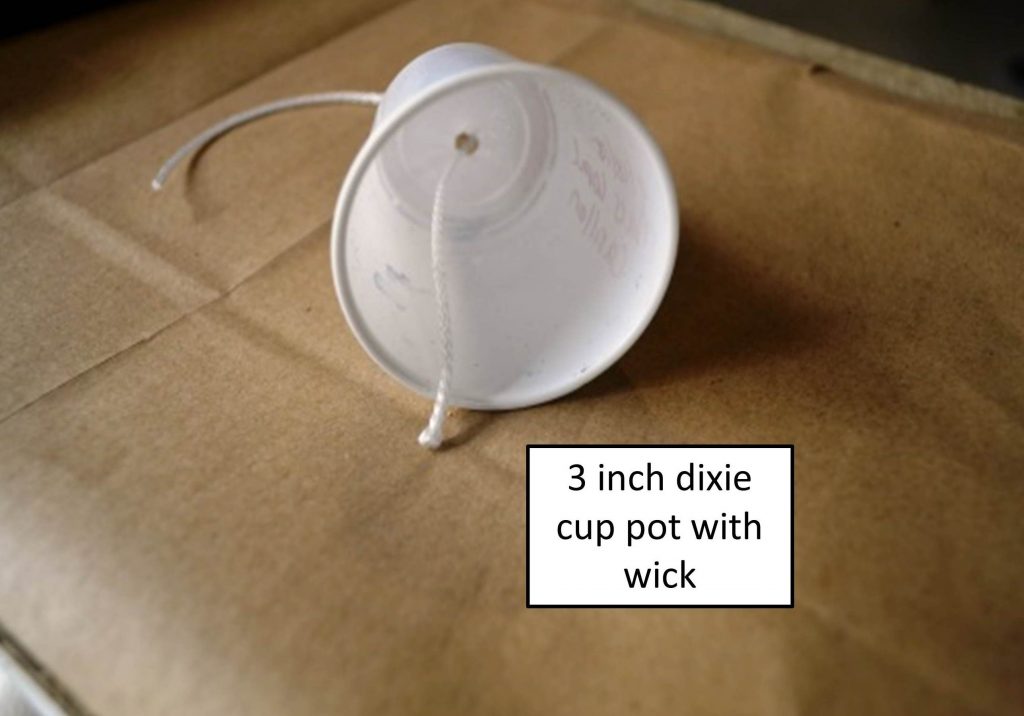
- First, cut a piece of wick 6”-8” in length and soak the wick in room temperature water (as shown below). If the wick material does not readily absorb the water, you can add few drops of soap to the water and soak the wick again.
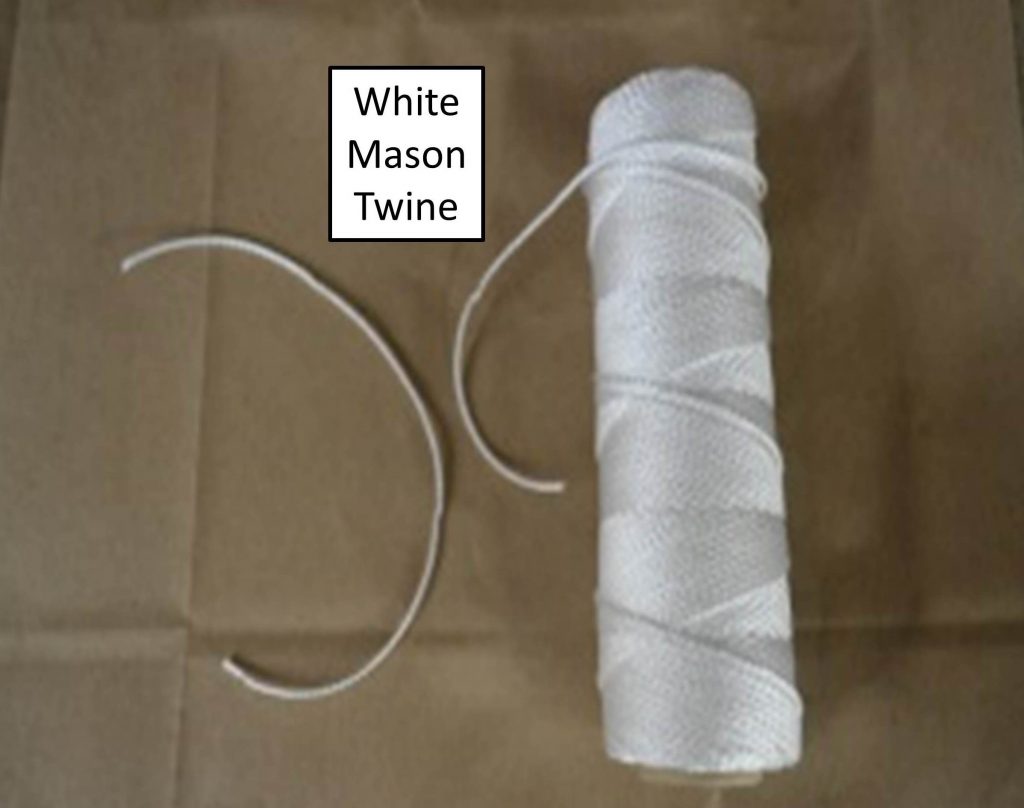

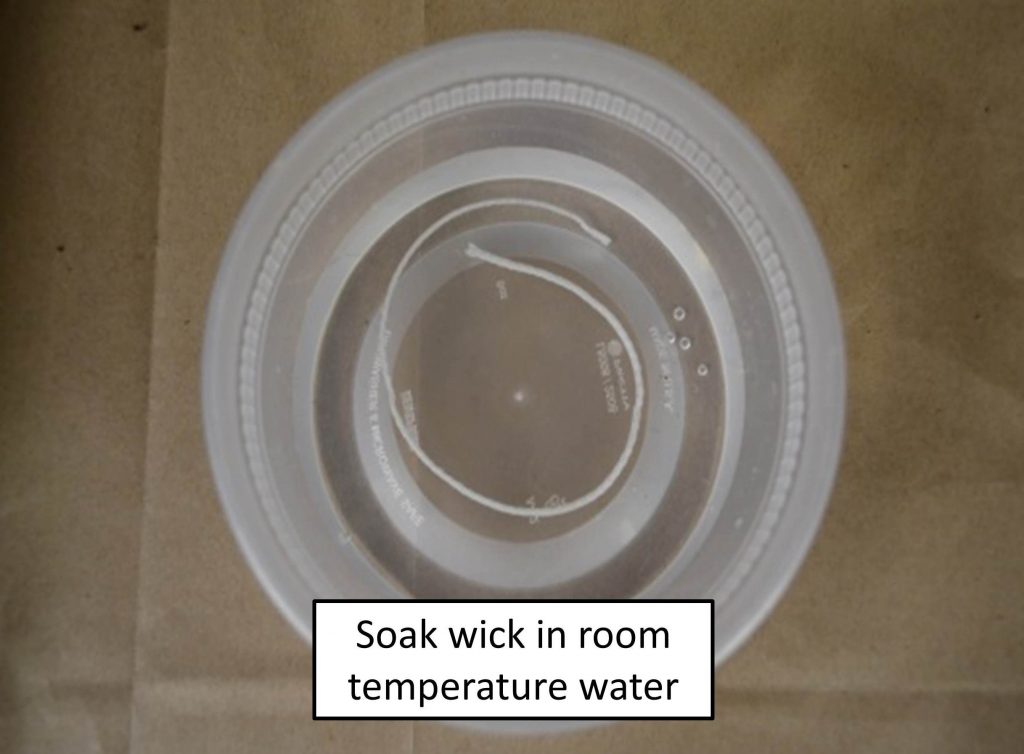
- Then thread it through one of the drainage holes of the pot and over the top rim of the pot. At the top of the pot, the wick should be 1” in length or less over the rim and at the bottom there should be at least 2” of wick dangling from the drainage hole (as shown below).
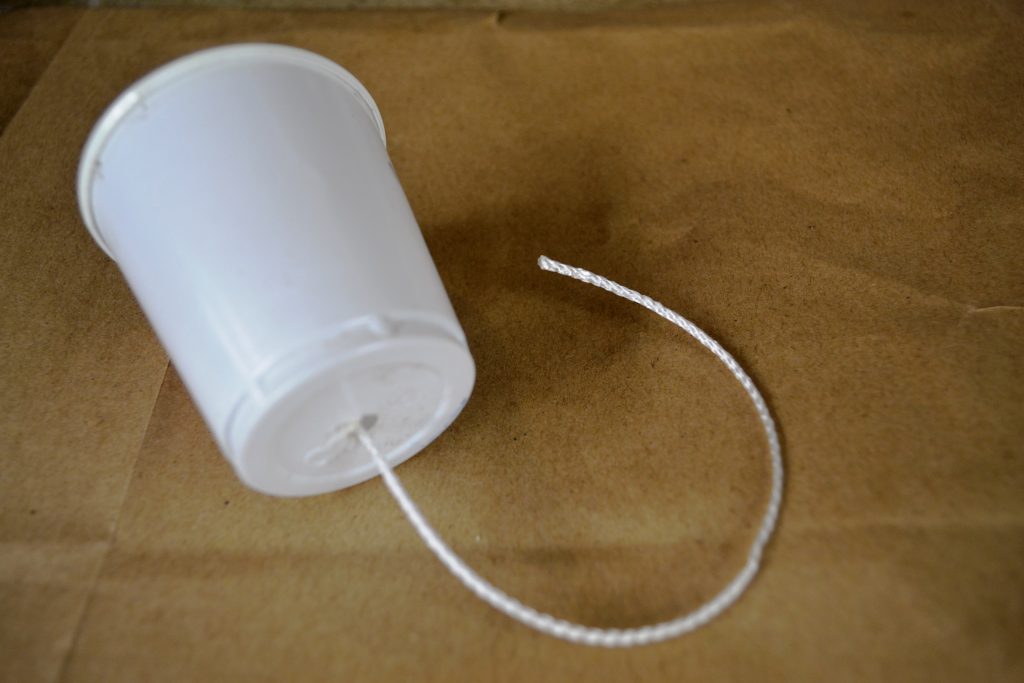
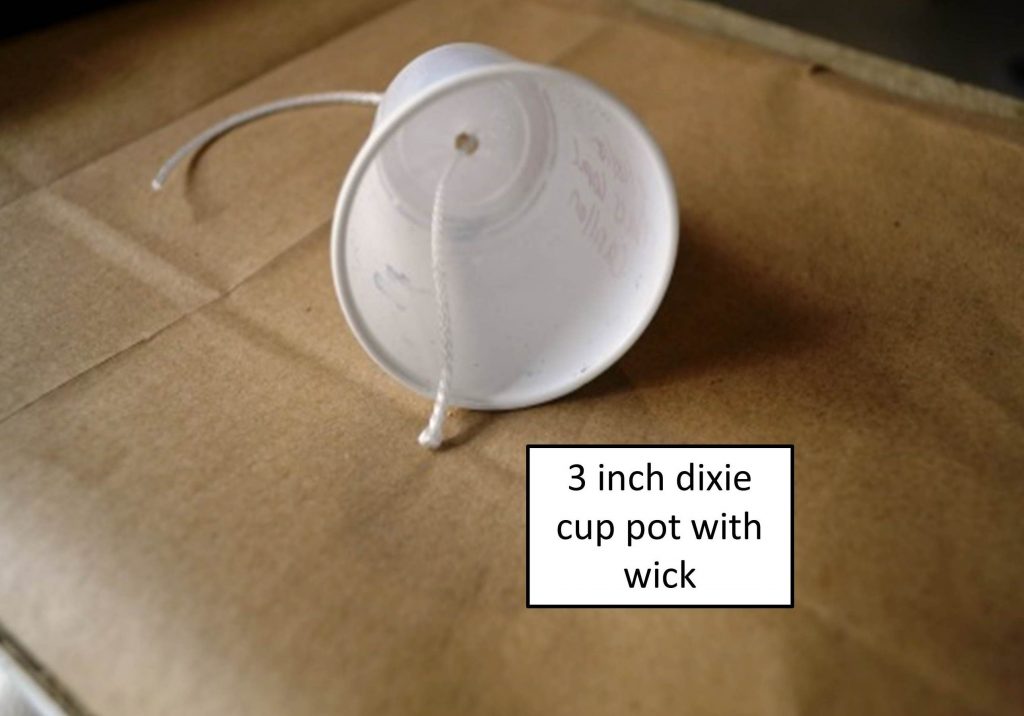
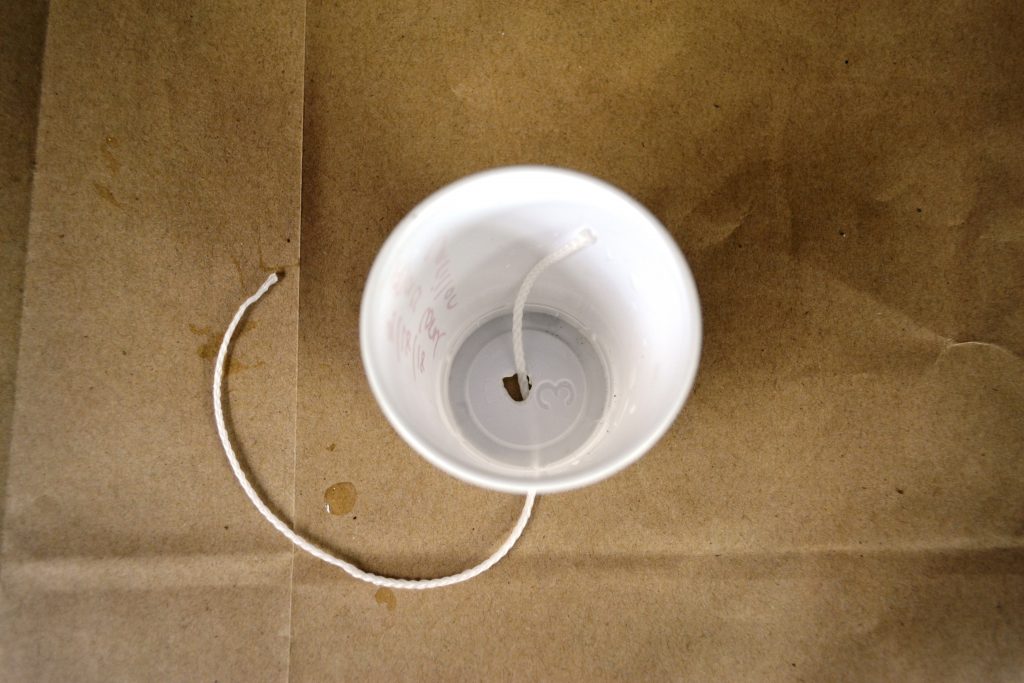
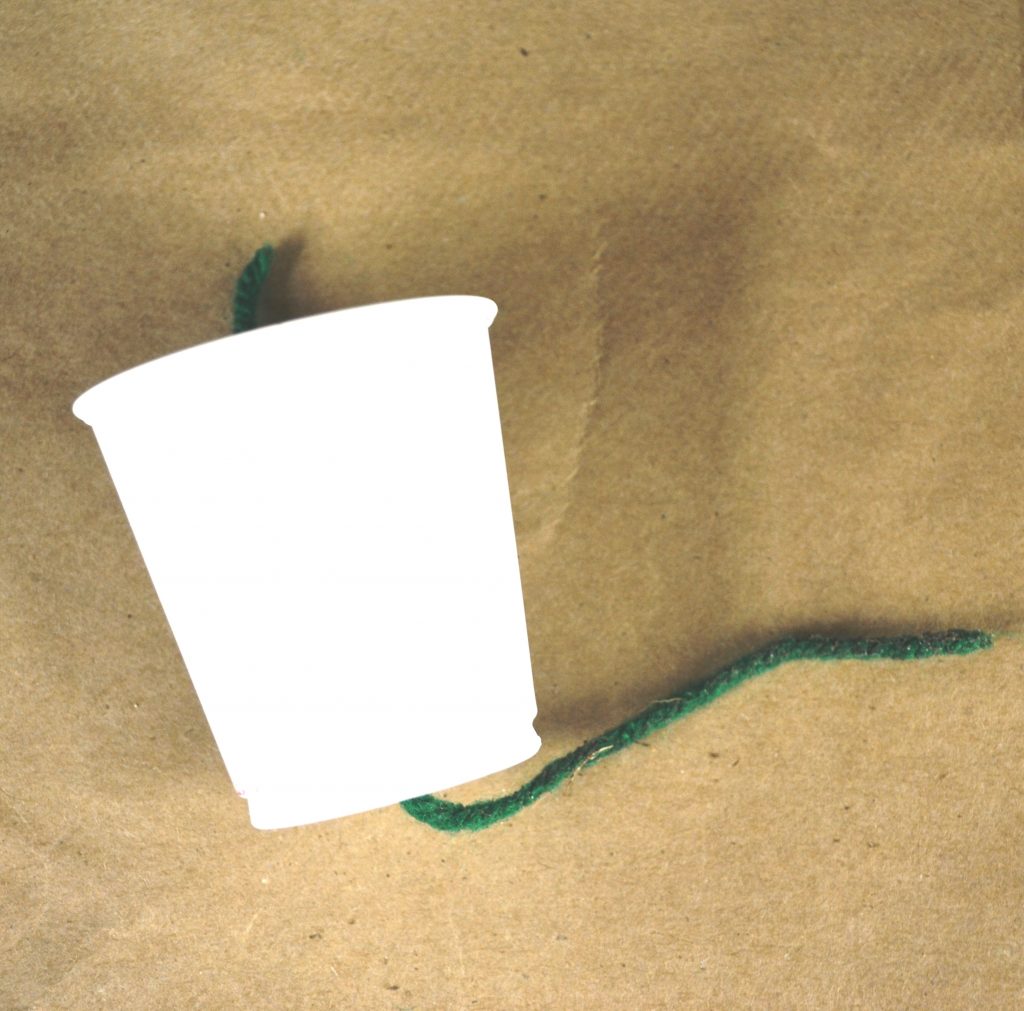
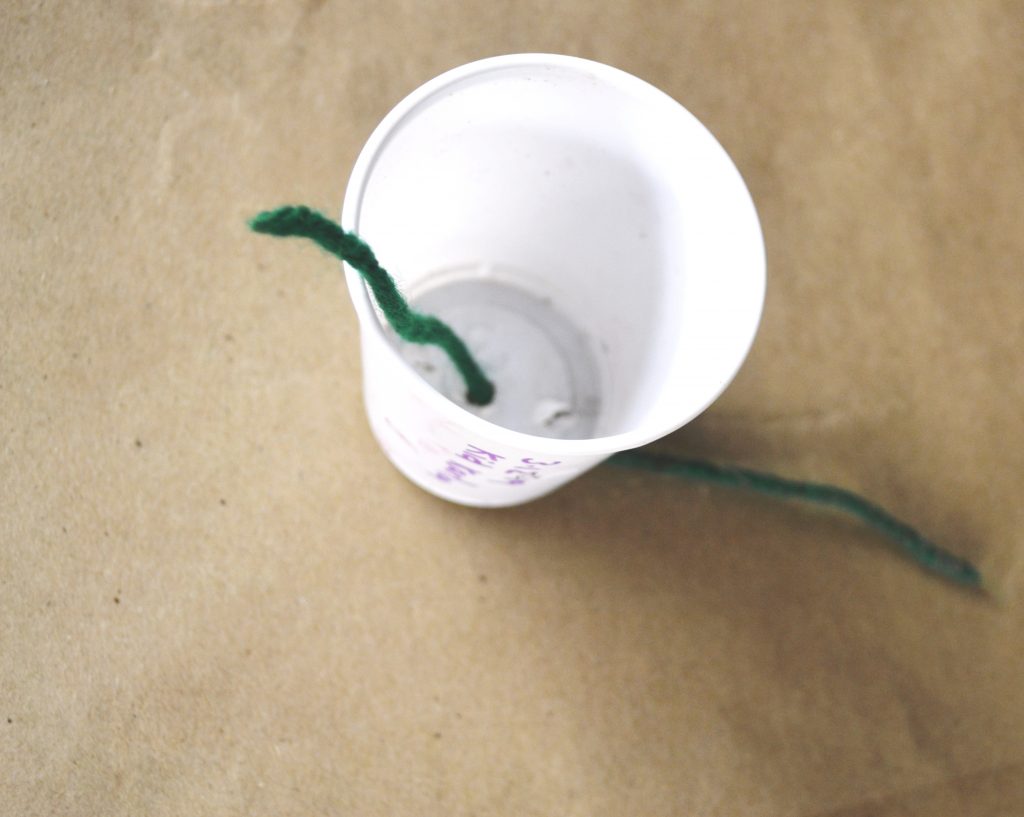
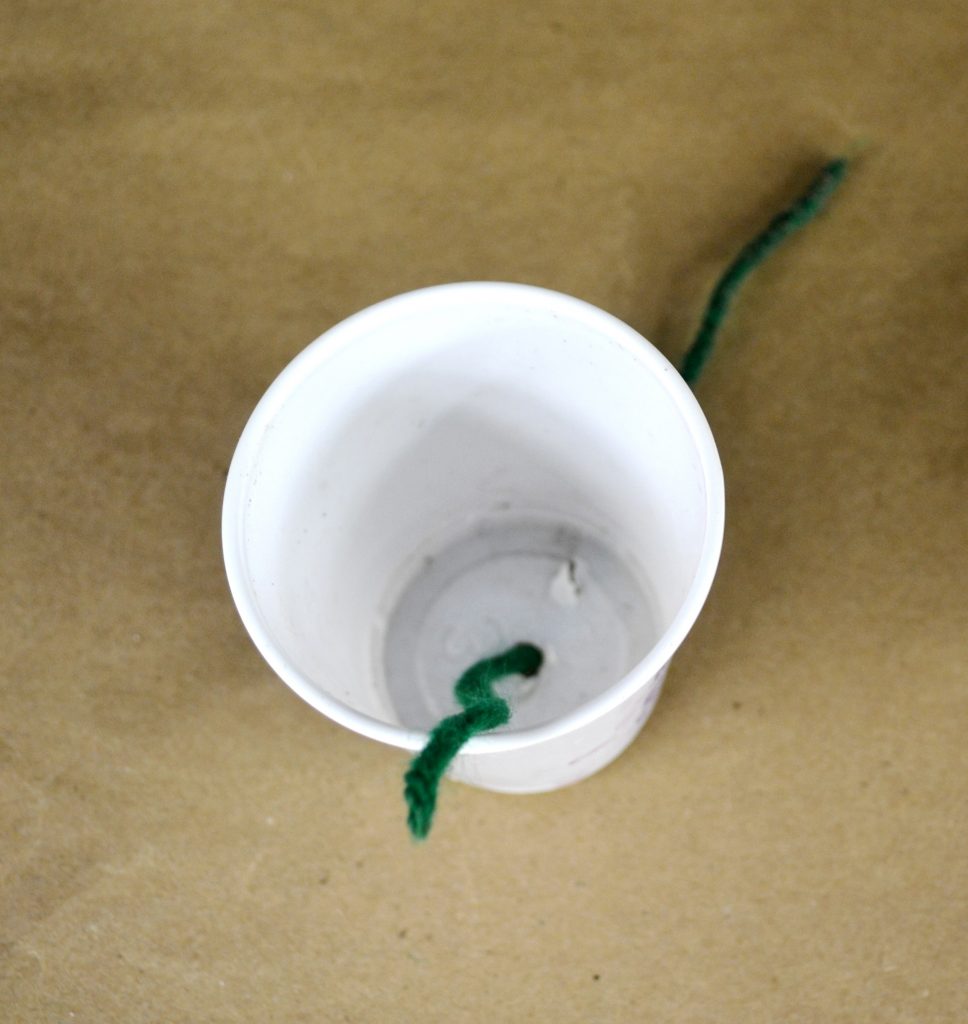
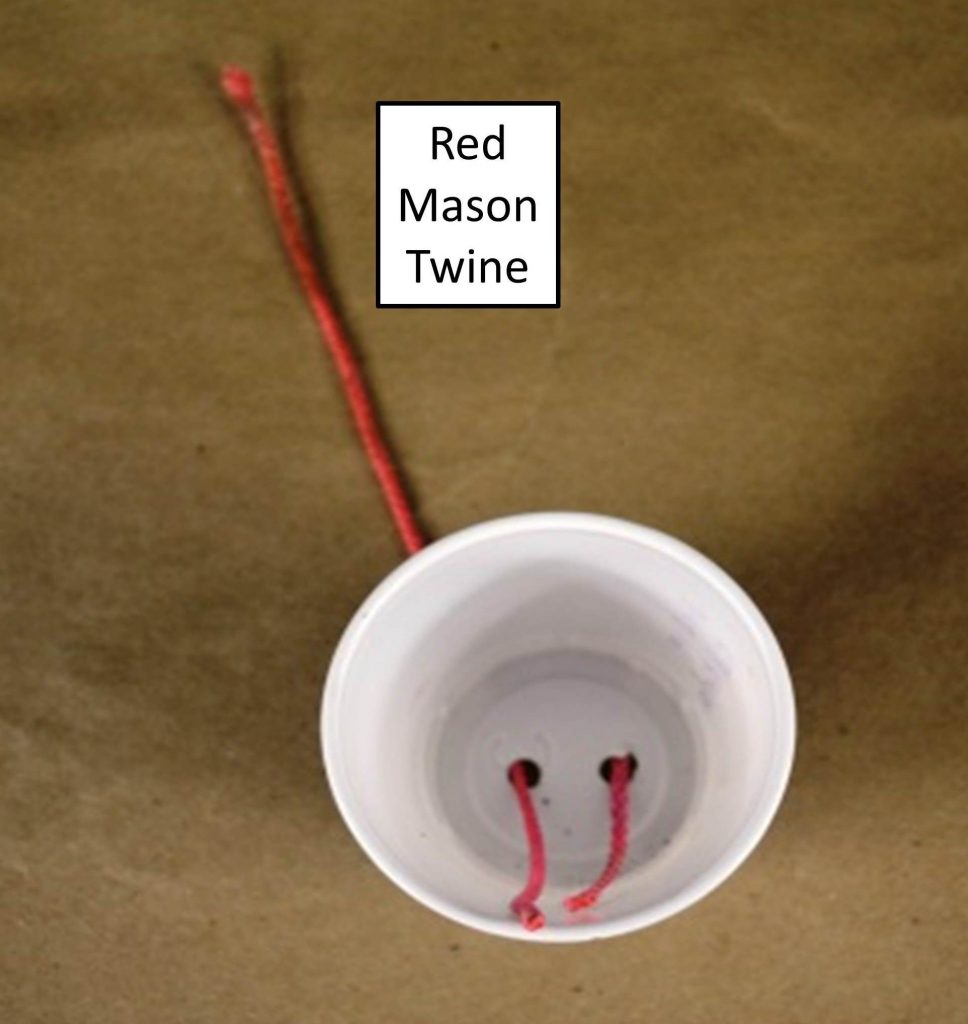
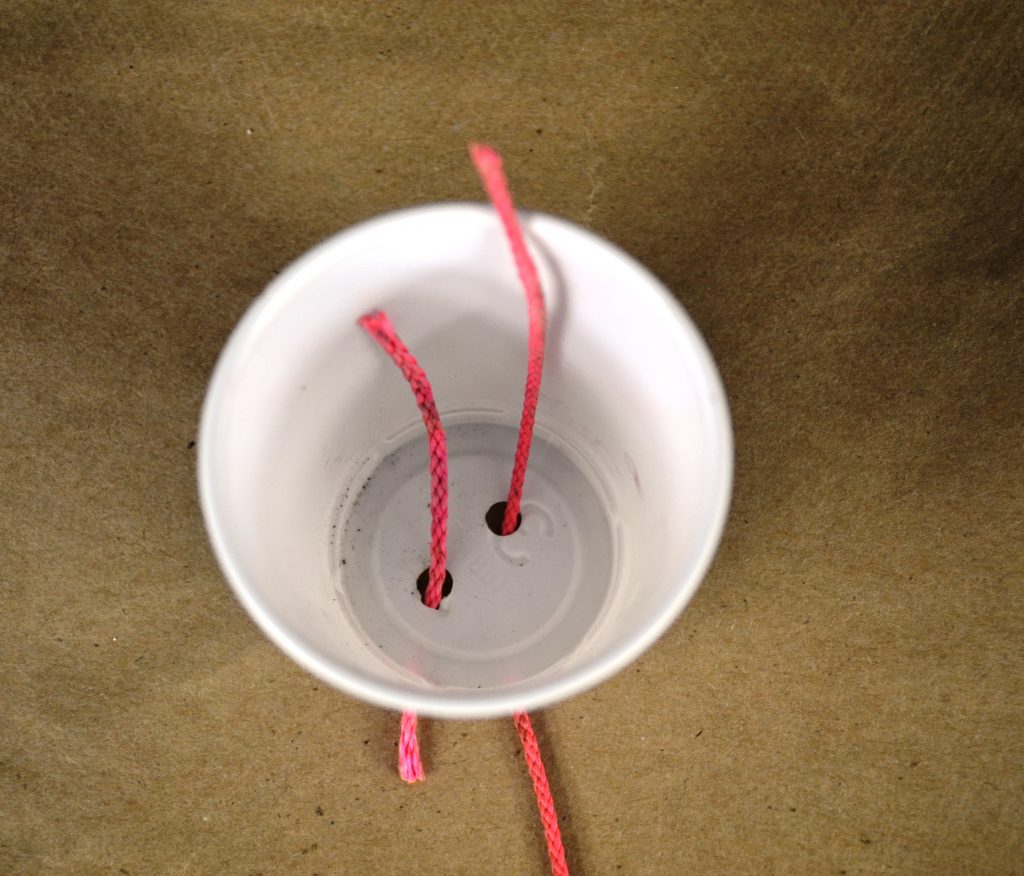
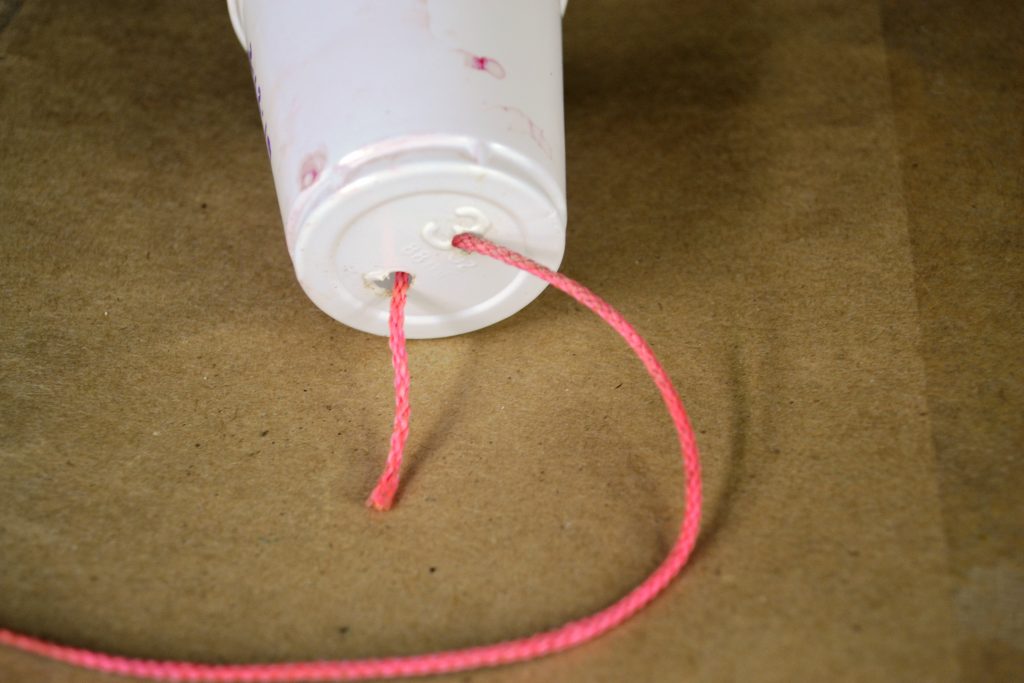
- NOTE: If you don’t have enough wick length, then it’s not necessary to have the wick dangle 1″ from the top, that is optional and personal preference.
- In this example we are using a heavy/thick wick, so one wick per pot is enough for a 3” – 4.5” pot. If we used a thin wick, we would insert two individual wicks through two individual drainage holes on either side of the pot, for a 3”-4.5” pot.
- Finally, fill the pot with potting mix and plant the violet.
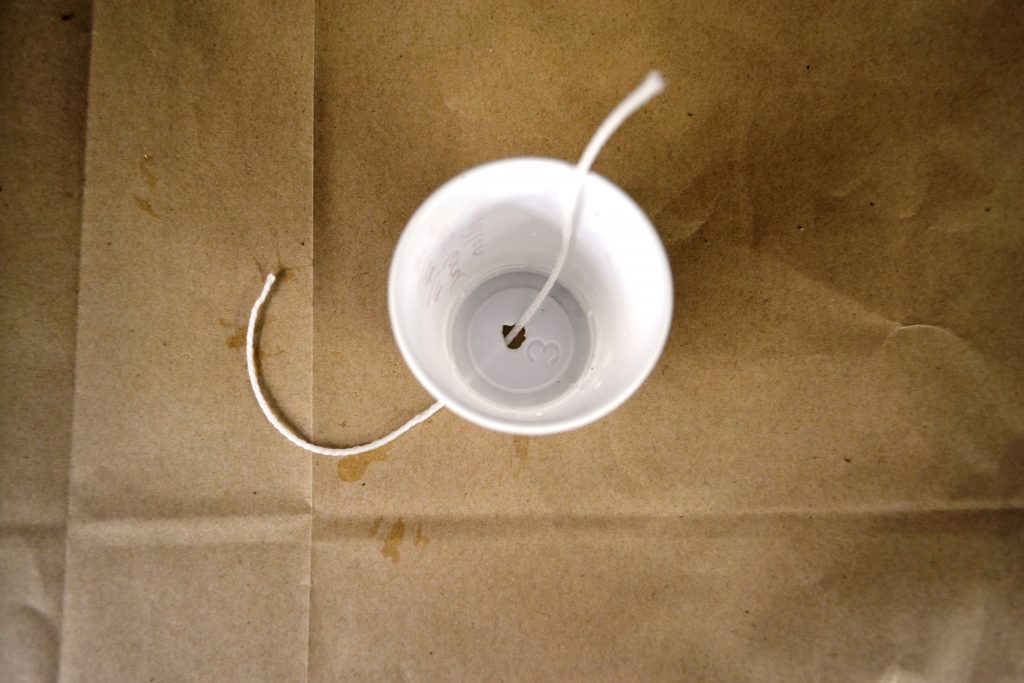
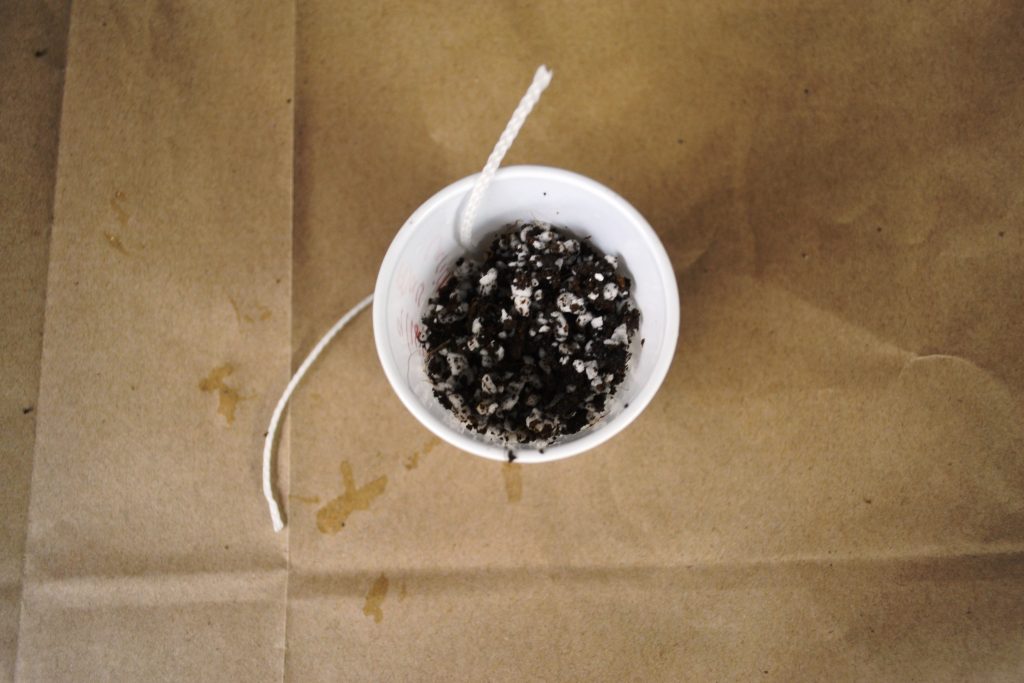

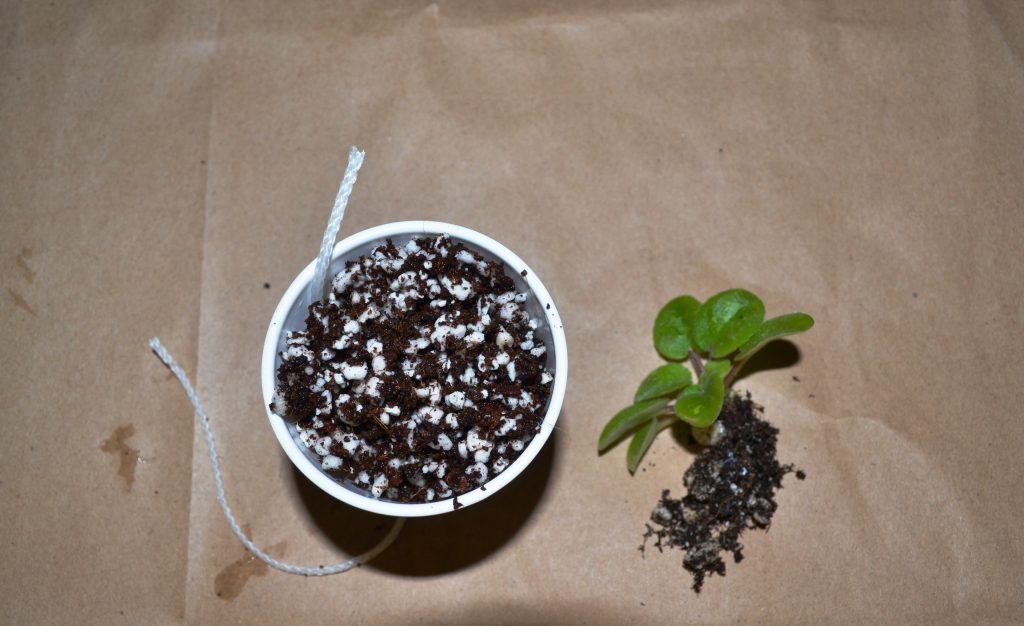
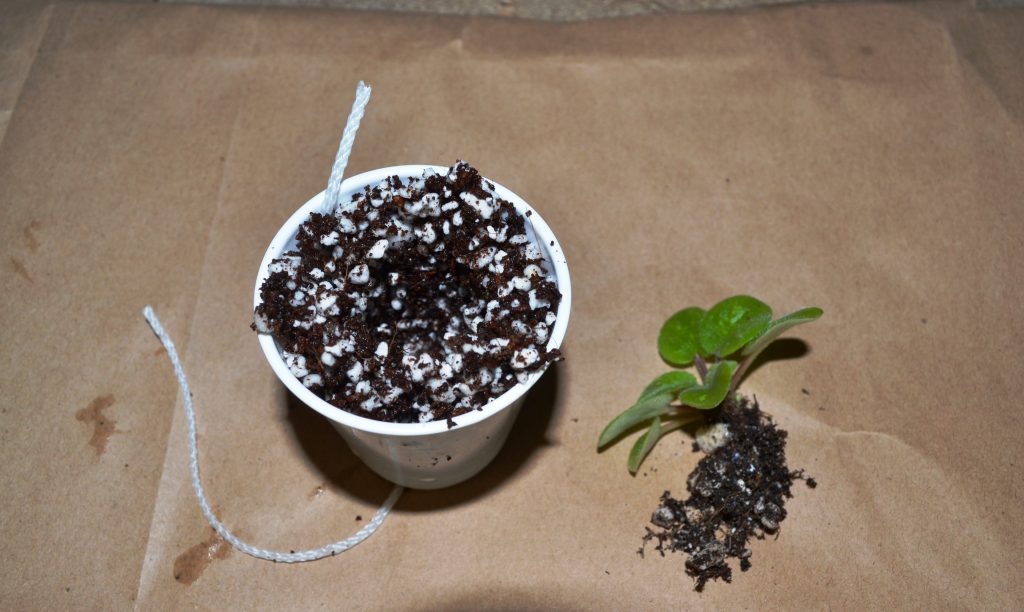
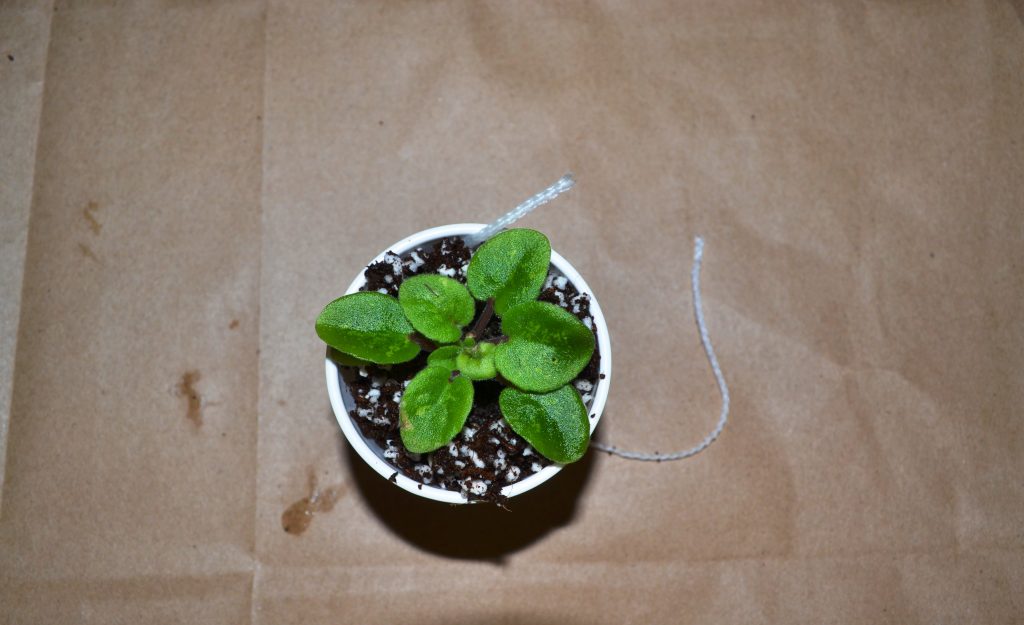
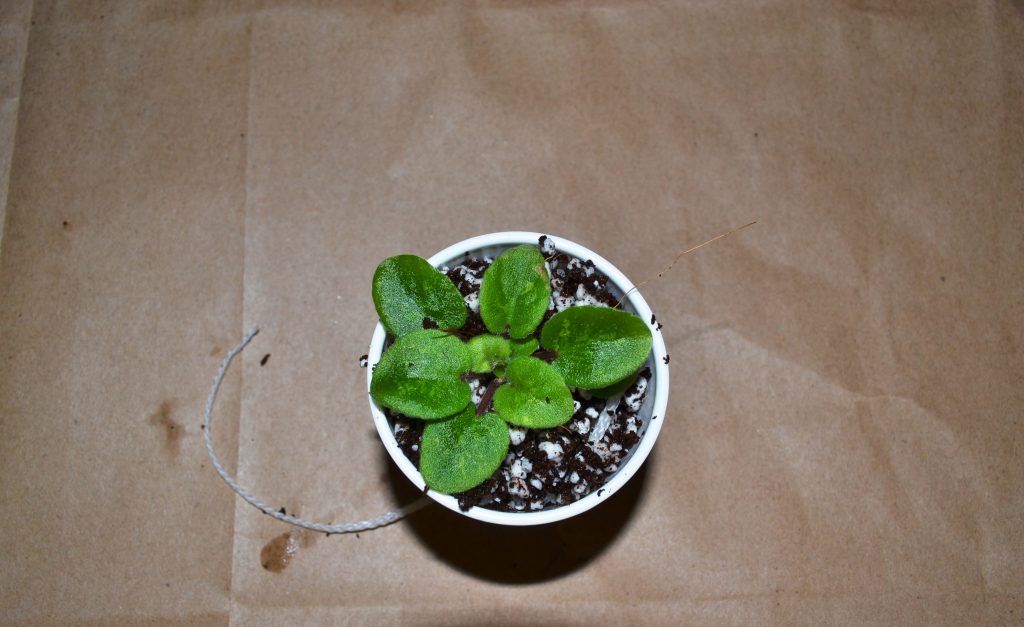
- Place the threaded wick at the bottom into a water reservoir, in a way that only the wick hangs in the water and any part of the pot does not touch the water (as shown below).
- Make sure the pot is not sitting in water (as shown below), otherwise the roots will start to rot due to overwatering.
How to wick already potted African Violet plants?
- If you already have an African Violet plant that is already potted up and comfortable in its own pot/soil. You can also wick this plant with minimal disturbance.
- First soak the wick in room temperature water (6-8” in length). If the wick material does not readily absorb the water, you can add few drops of soap to the water and soak the wick again (as seen below).
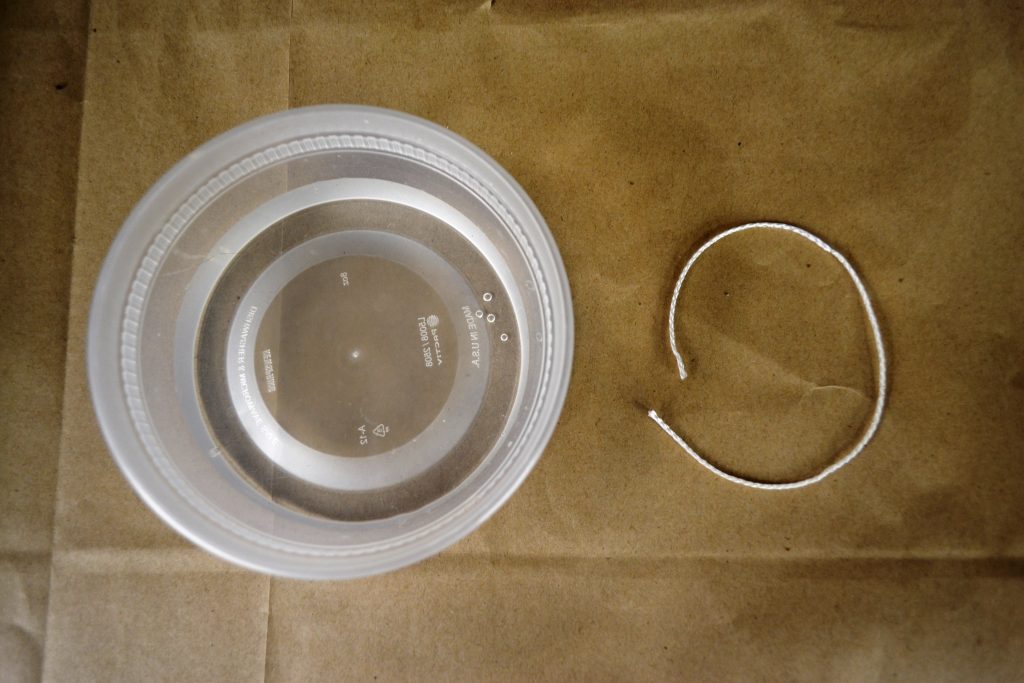
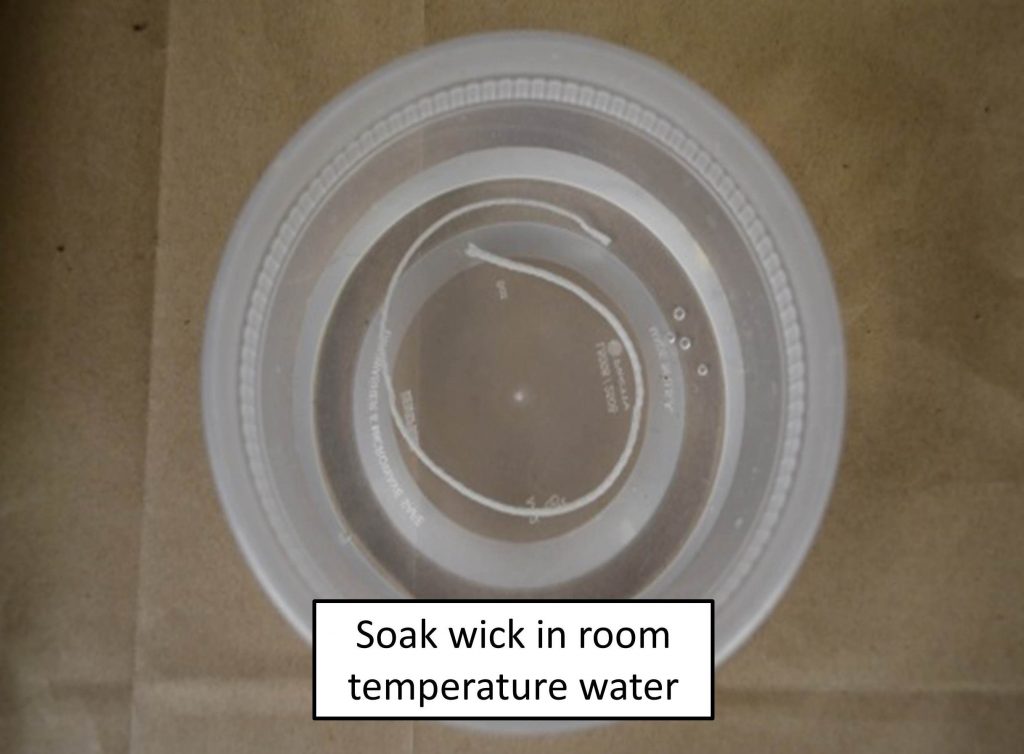
- Using a knitting needle or a similar long threading needle, carefully thread the wick by pushing the needle through one of the drainage holes in the pot and gently pull the needle to the top of the pot along with the wick. Try to push the needle through a clear area in the soil avoiding tearing through the leaves (as seen below).
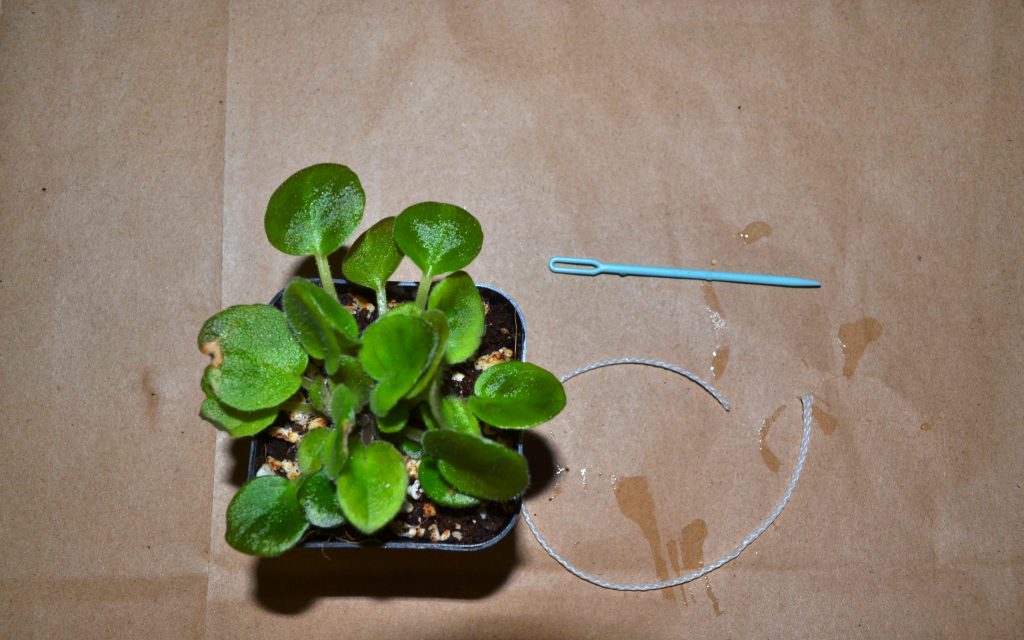
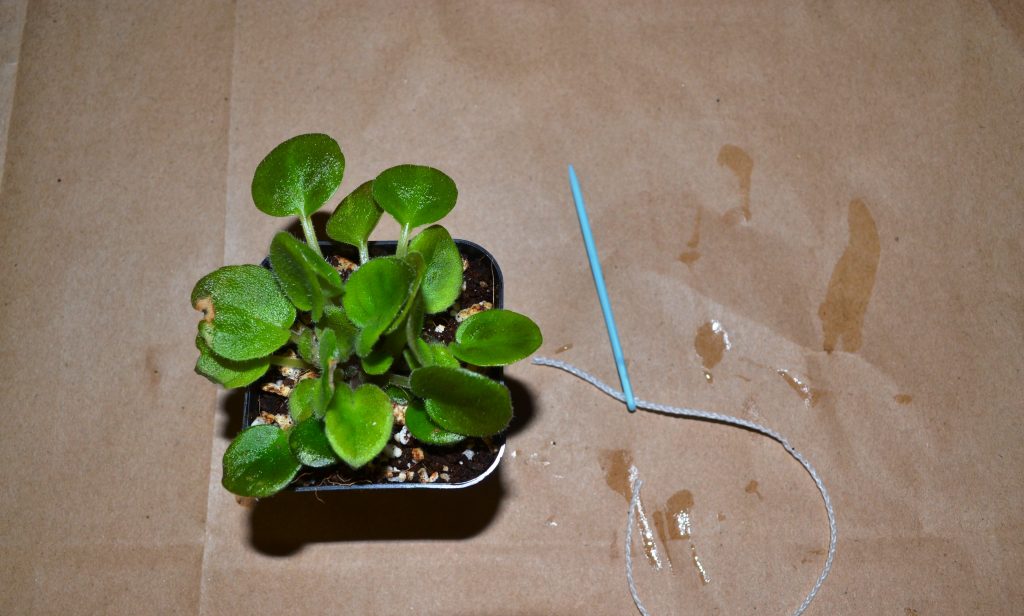
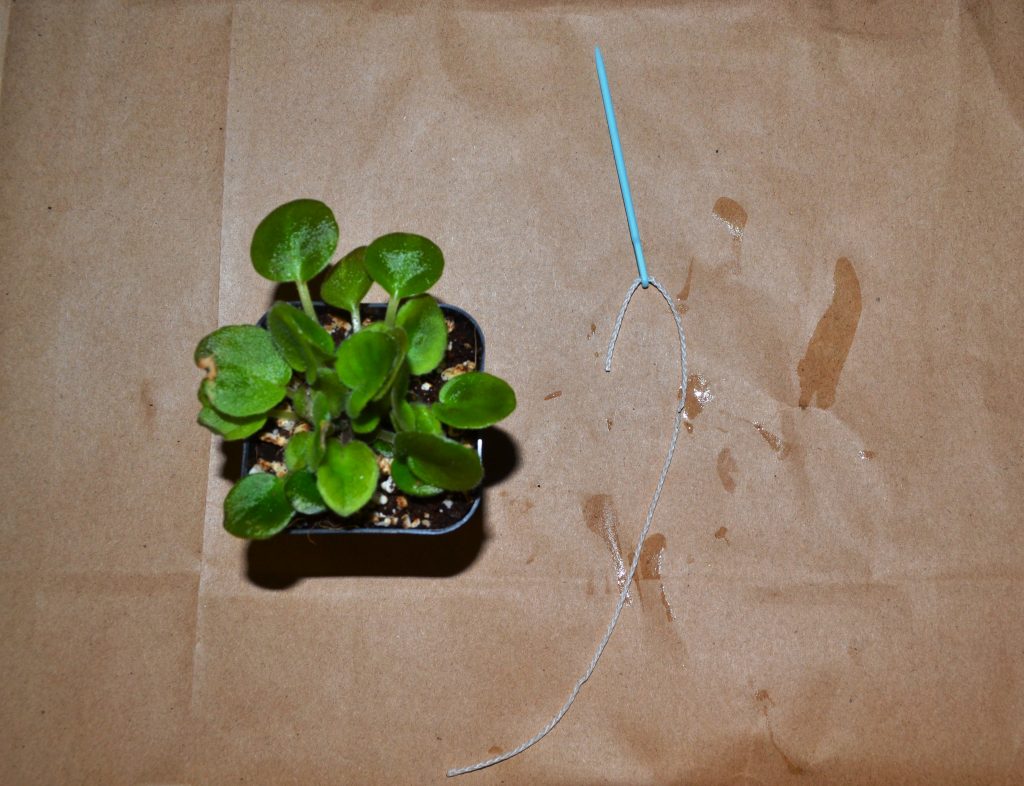
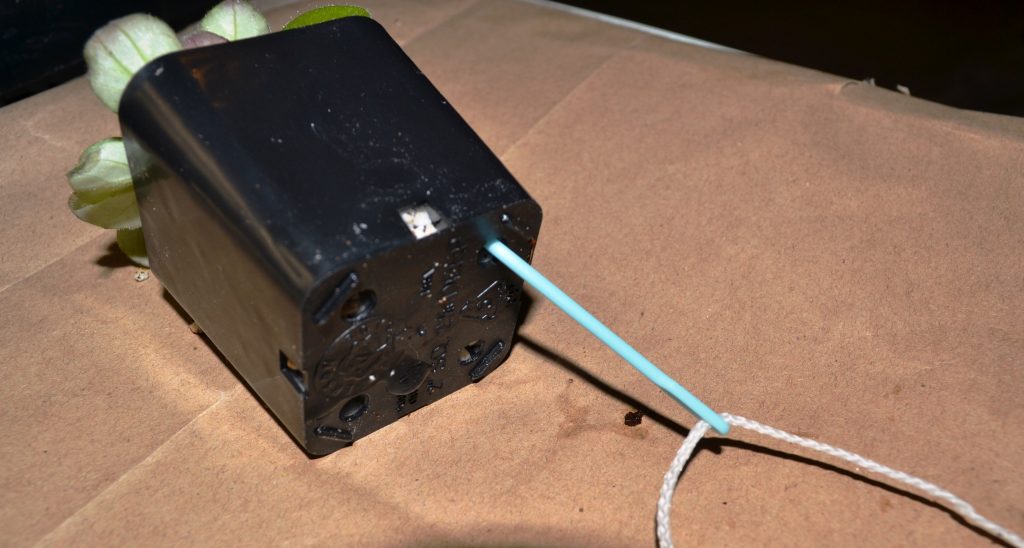
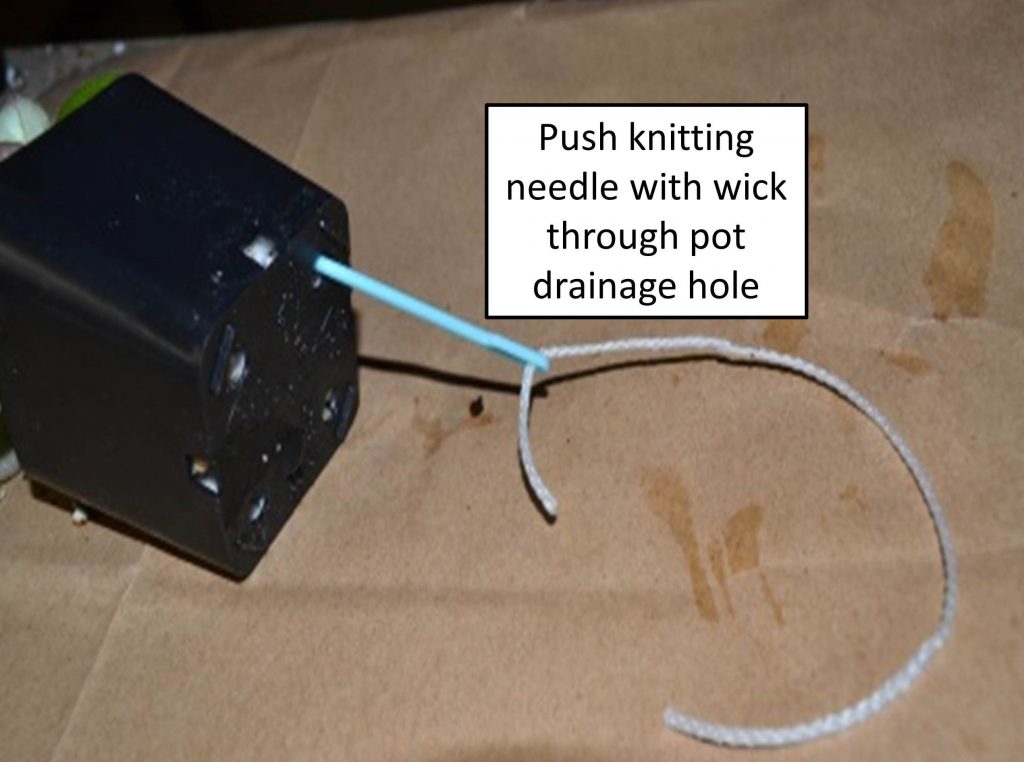
- Once the wick is visible at the top, pull 1” of the wick at the top and cut off the needle. Make sure there is enough wick hanging from below the drainage hole to lay into the water reservoir/container below (as seen below).
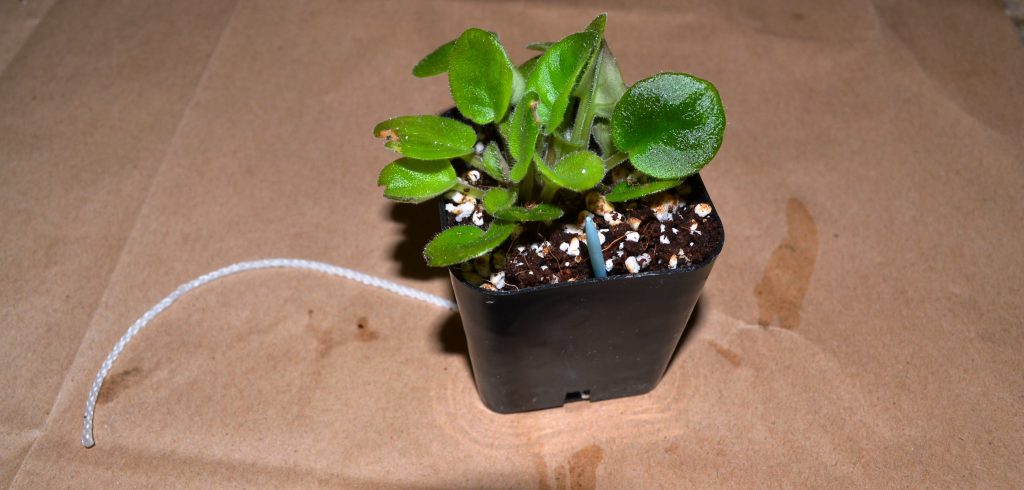
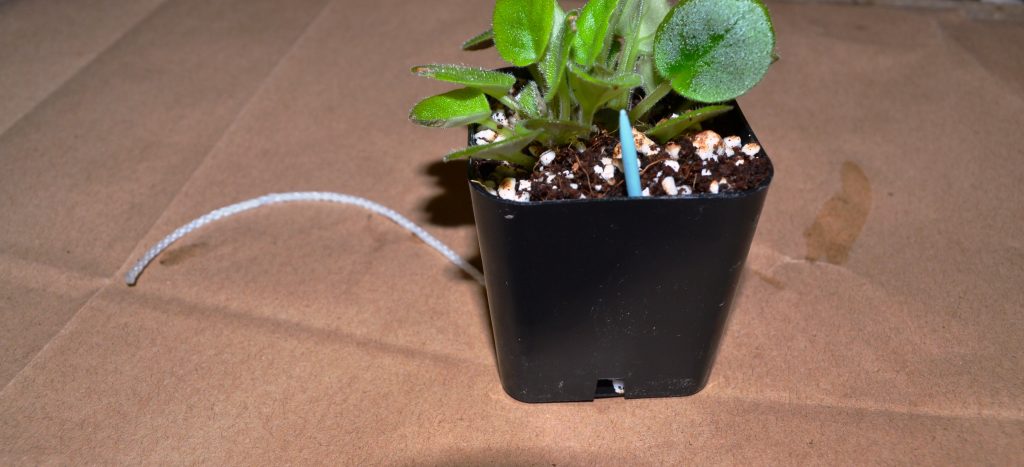
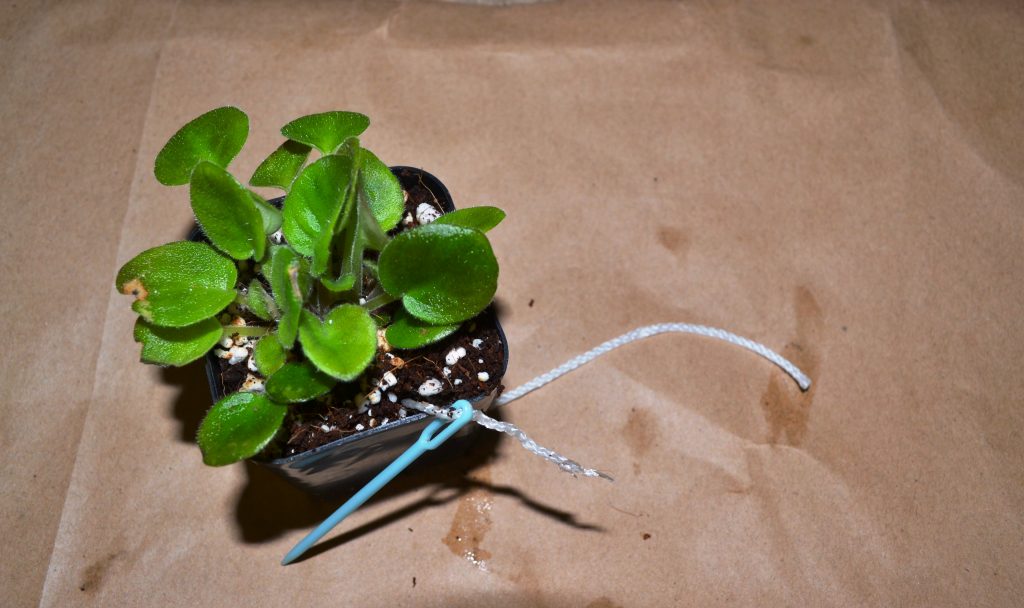
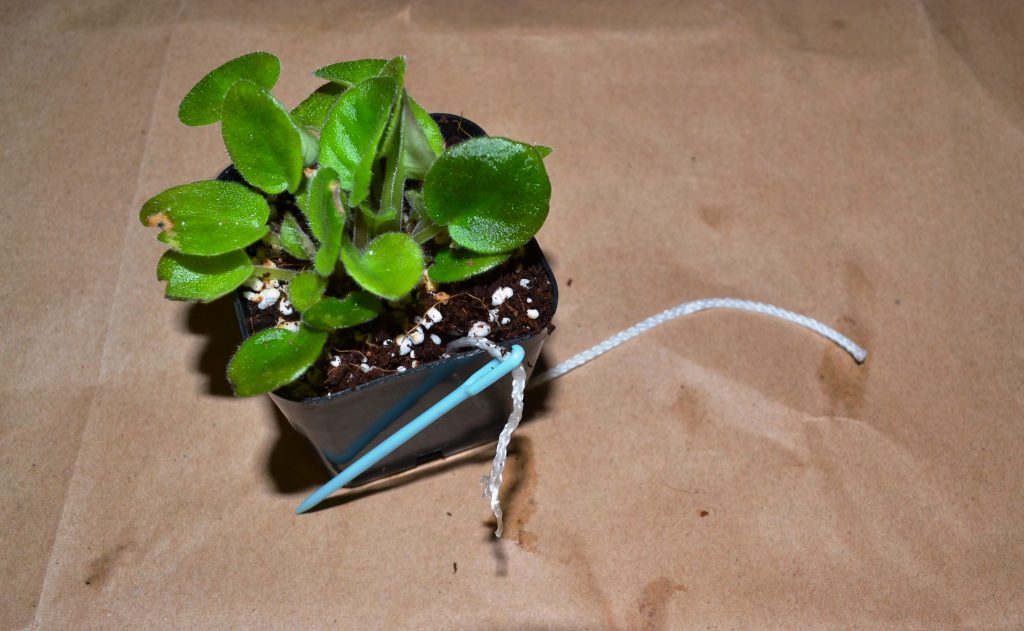
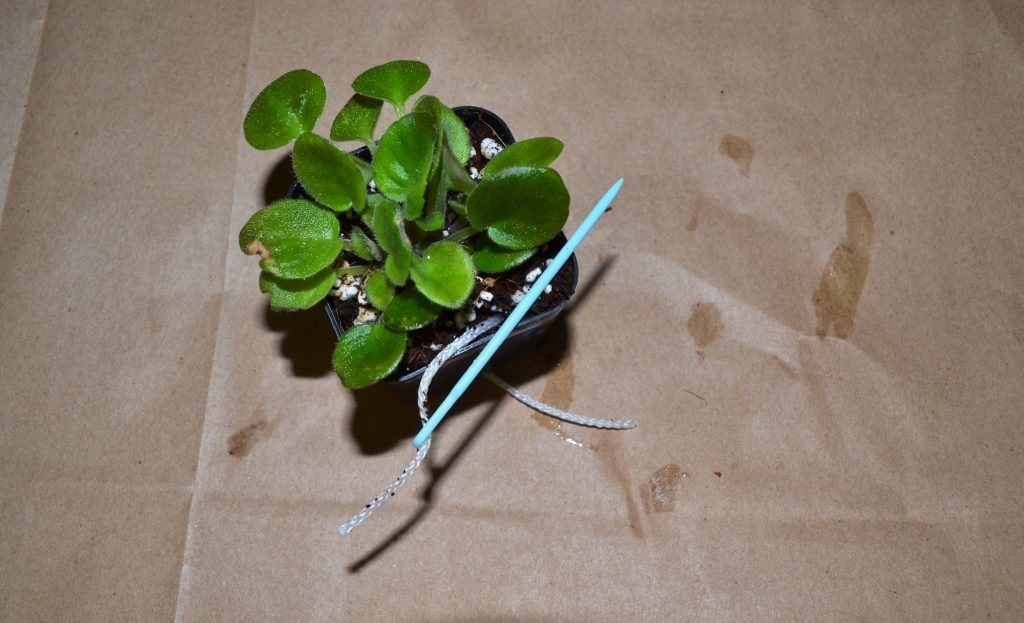
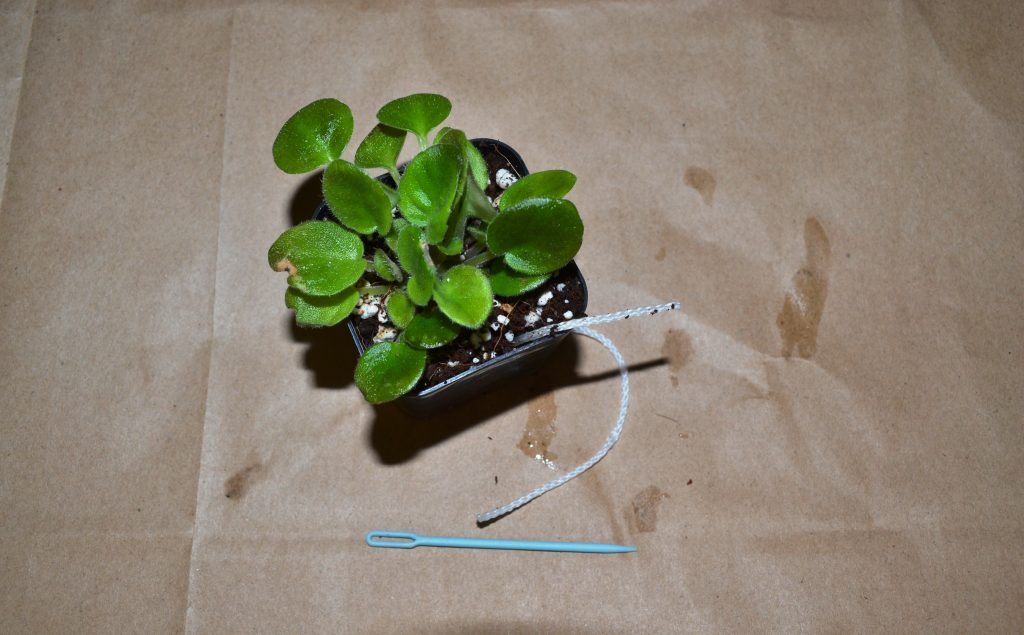
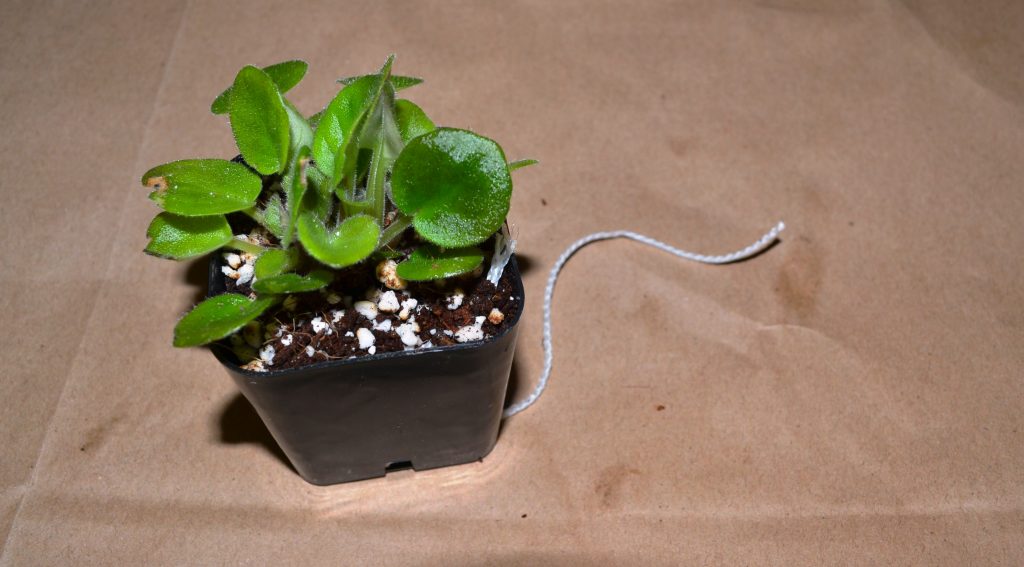
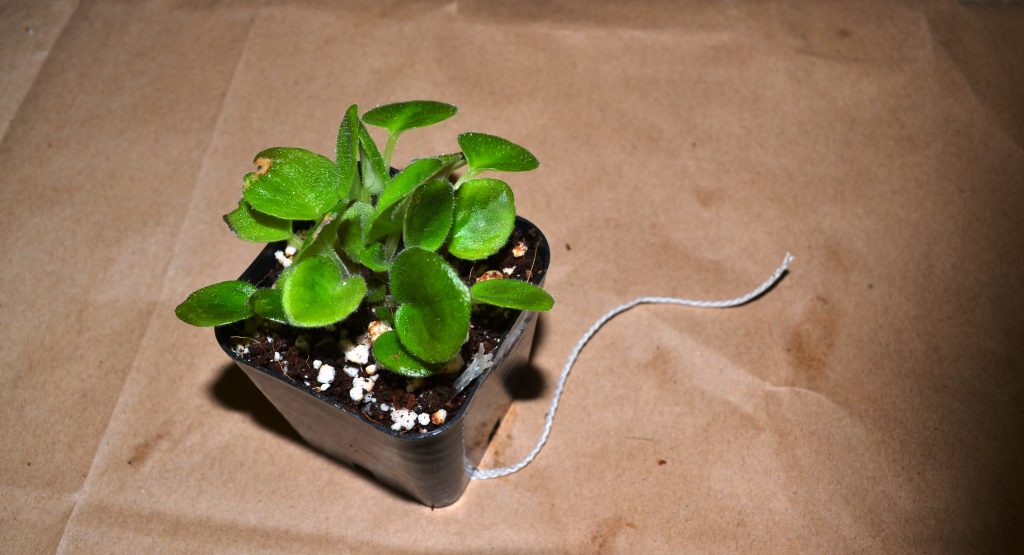
What type of wicks can I use for African Violet plants?
- Wicks used in African Violet wicking systems should be made of inorganic /synthetic/man-made/artificial material.
- These include acrylic yarn, acrylic cord, rayon, nylon yarn, nylon twine, nylon cording (as seen below)- masons twine from Home Depot or lowes (3 ply).
- I use #18 mason twine. The diameter of the twine is 1/16th of an inch (0.0625inch) or 1.58mm. The diameter can vary by manufacturer slightly, I have found #18 mason in 1.52mm also. This will work fine too.
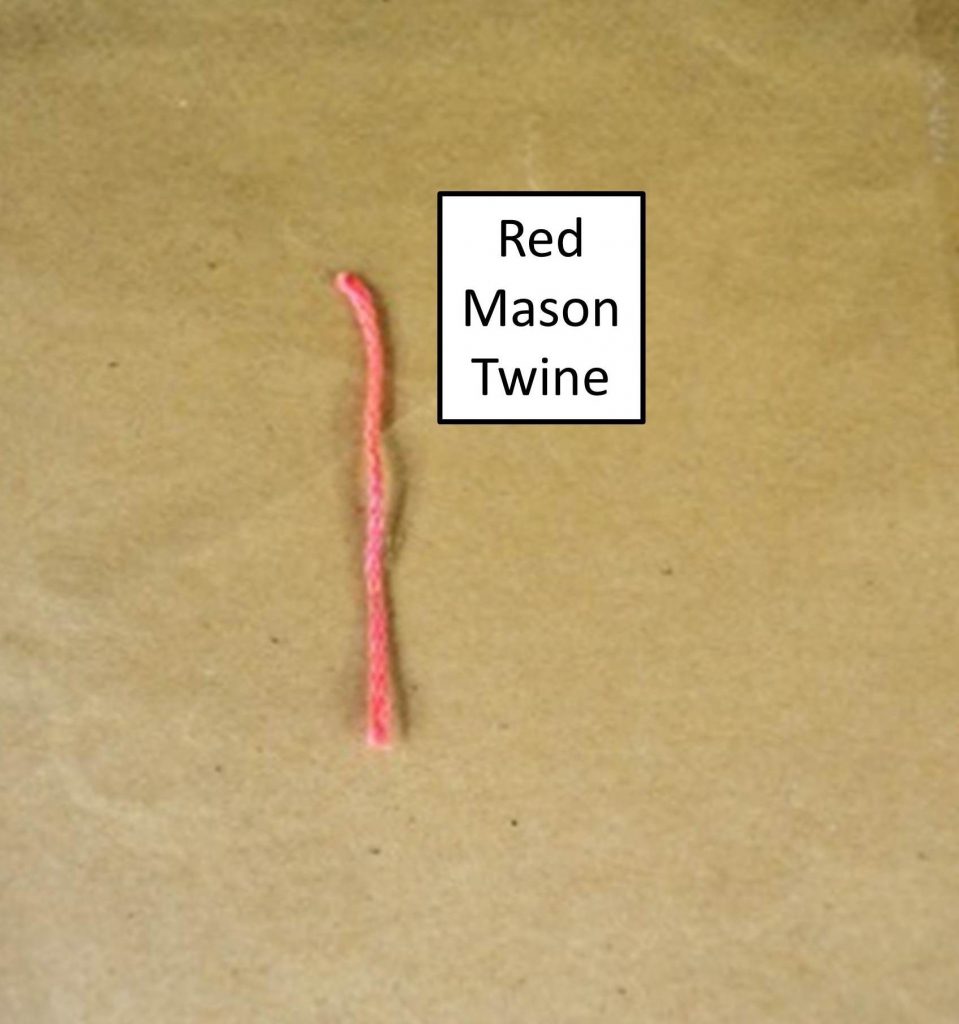
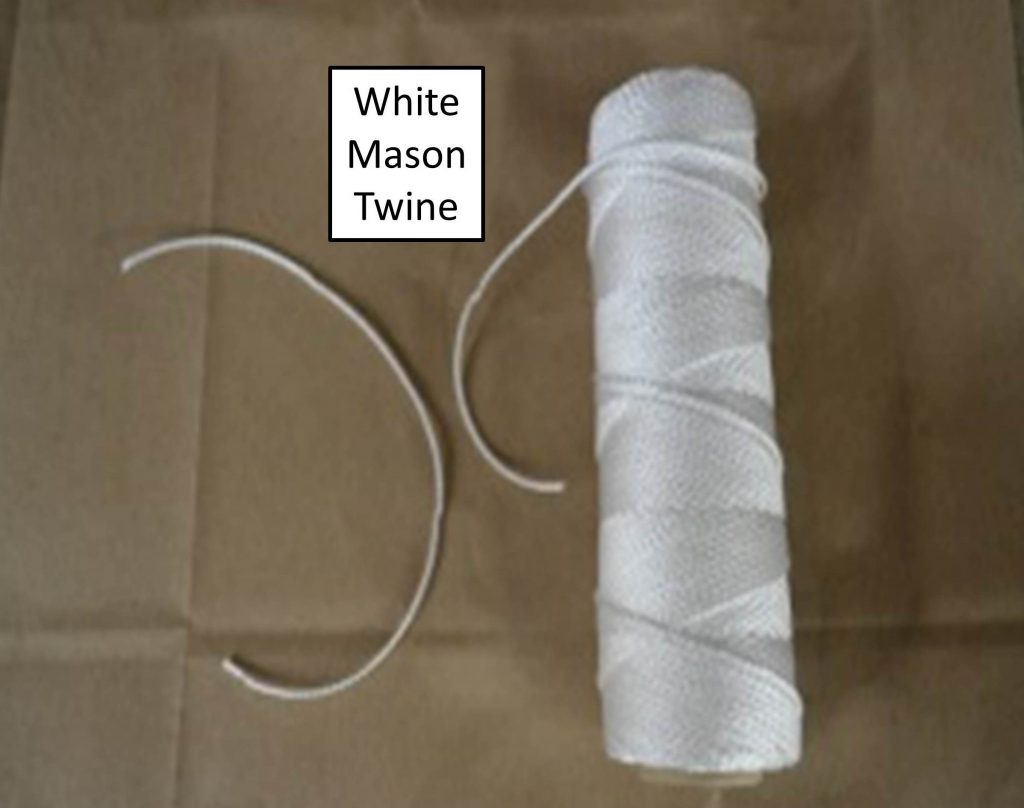
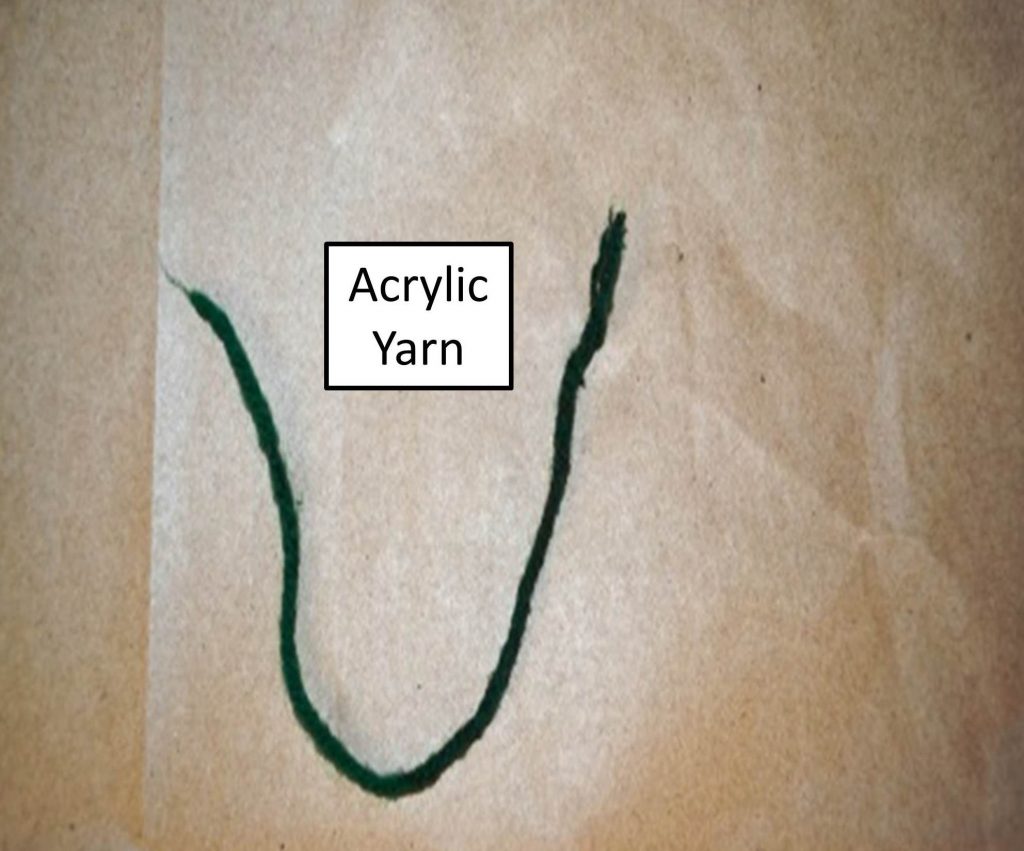
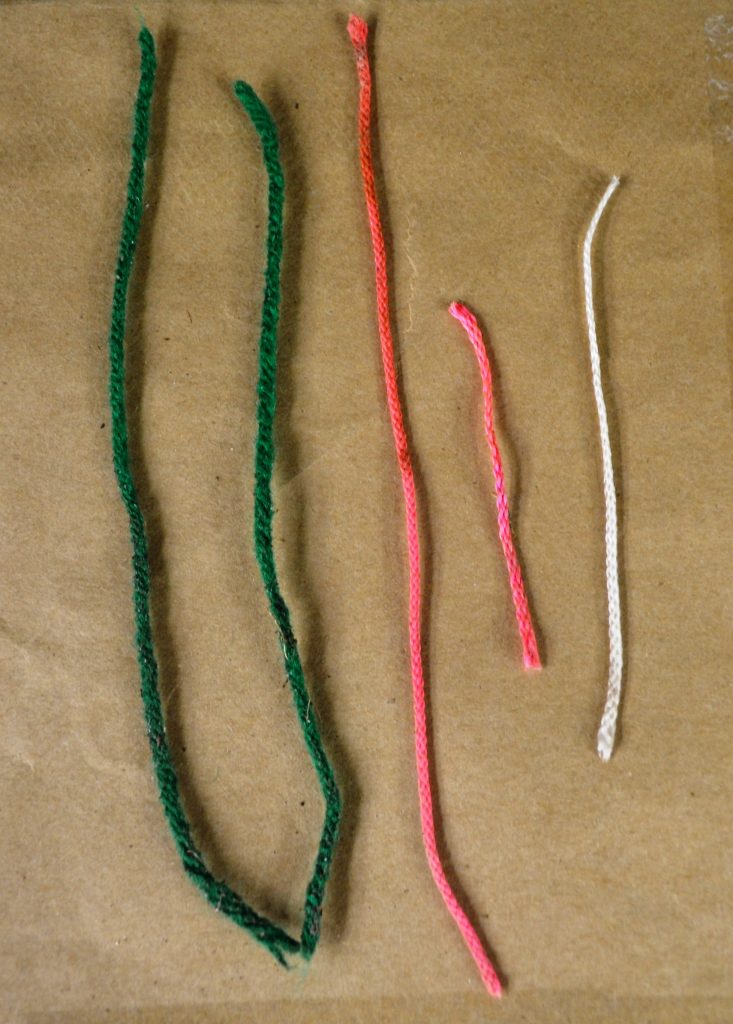
- Do not use cotton or wool as these are natural materials and the natural fibers in them are susceptible to rotting.
- The average length of a wick should be 6”-8” long depending upon the size of the pot. Depending upon whether you are using a heavy/thick or thin wick, use 1 piece of wick or 2-3 pieces of thin wick per pot.
- You can also set up an experiment and see the difference between placing 1 wick in the pot verses 2-3 wicks and observe the rate at which the soil is moistened and how long it takes for the reservoir to be empty. This way you can be entirely sure how many wicks work best for your plant.
- Replace wicks after 6-8 months of use, as the fibers of the wick material will wear out and lead to inefficient water absorption. Also, soil particles, fertilizer salts and minerals from the water will start building up on the fibers again leading to inefficient water absorption.
Below are a few options of wicks which be used for regular pots and self watering pots too:
Potting Mix / Soil to encourage wick watering in African Violet plants?
- For wick watering African Violet plants, the potting mix / soil should be light and airy.
- This includes either a soilless mix of only vermiculite/perlite or a light soil mix of at least 50%-75% vermiculite or perlite and 50%-25% peat moss.
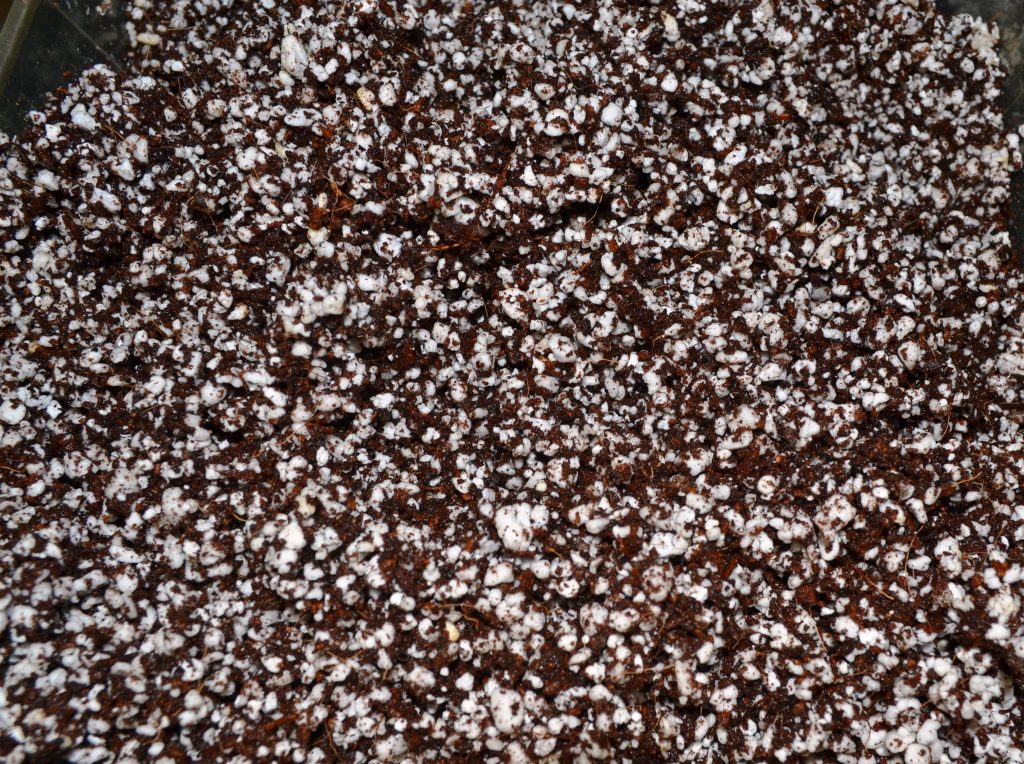
Below are perlite recommendations, useful as an additive to soil or even used a thin layer at the bottom of a pot for drainage.
Type of pot / container for water – wicked African Violet plants?
- For water wicked African Violet plants, the best pots to use are plastic pots. Ceramic pots can also be used, but I prefer plastic pots.
- Plastic pots allow slow water evaporation from the soil as they hold water. They are also easier to clean and store, light weight and more durable.
- Clay pots are not suitable for water wicked African Violet plants, as they induce fast water evaporation from the soil and sides of the pot due to their porous material.
- As a result in clay pots the soil dries out frequently and the African Violet plant needs be watered frequently.
- Clay pots also readily absorb fertilizer salts which leads to accumulation of mineral deposits, especially on the rims of the pots. This can burn the leaves of the African violet plant when in contact with the mineral deposit covered rim.
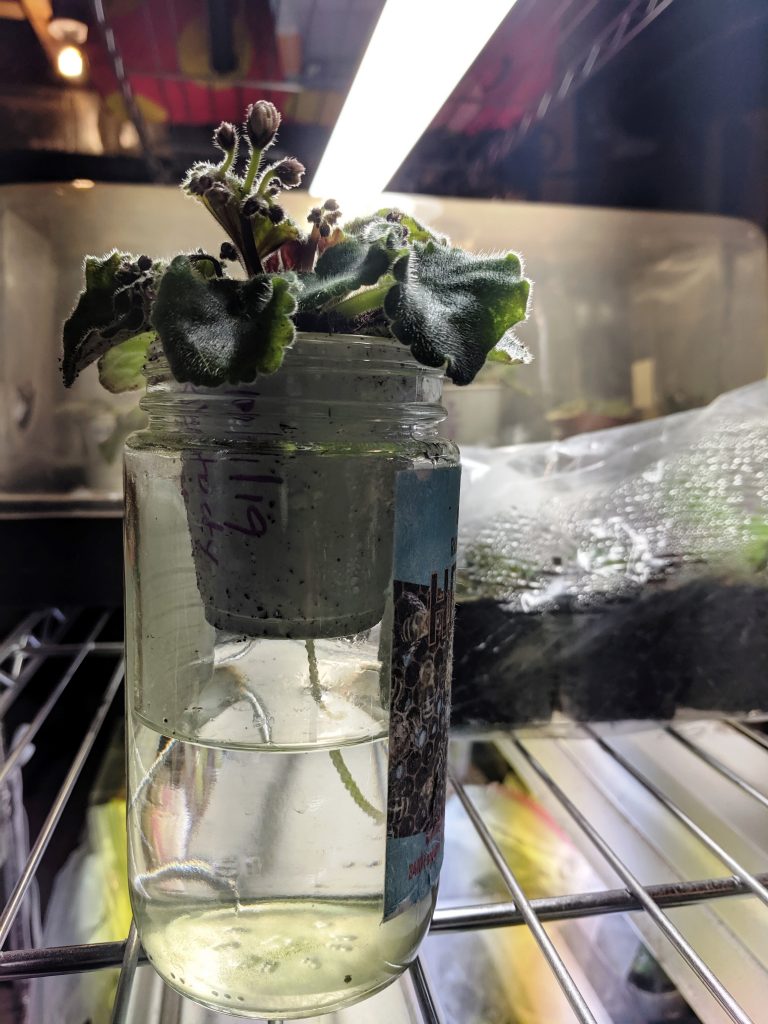
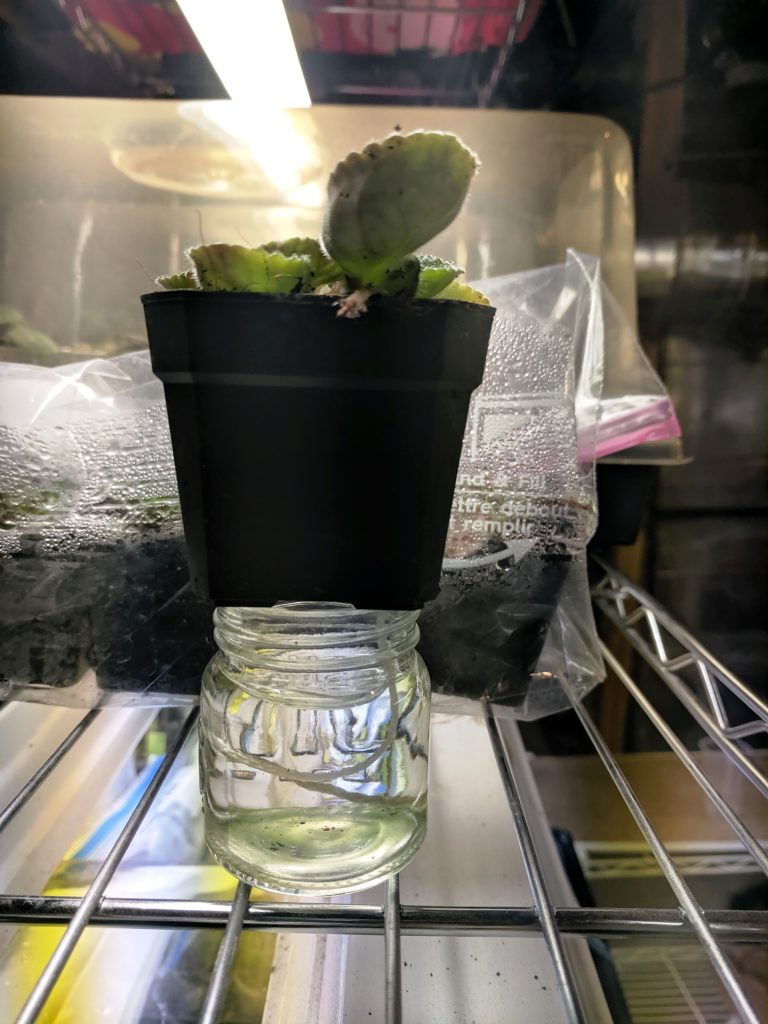
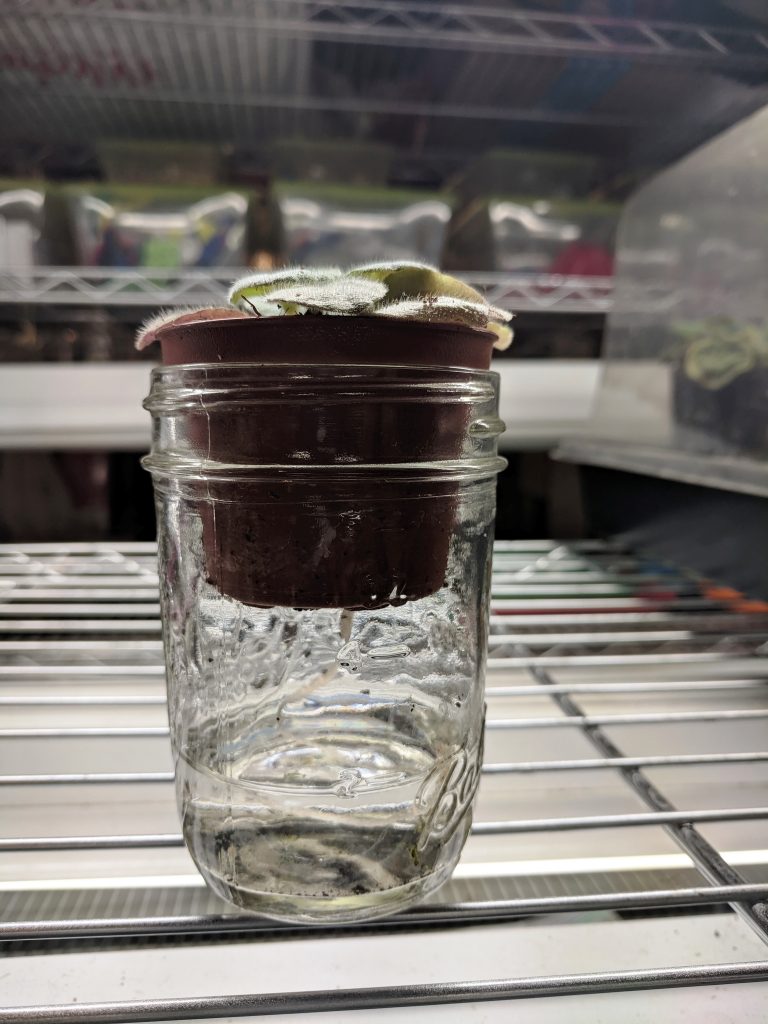
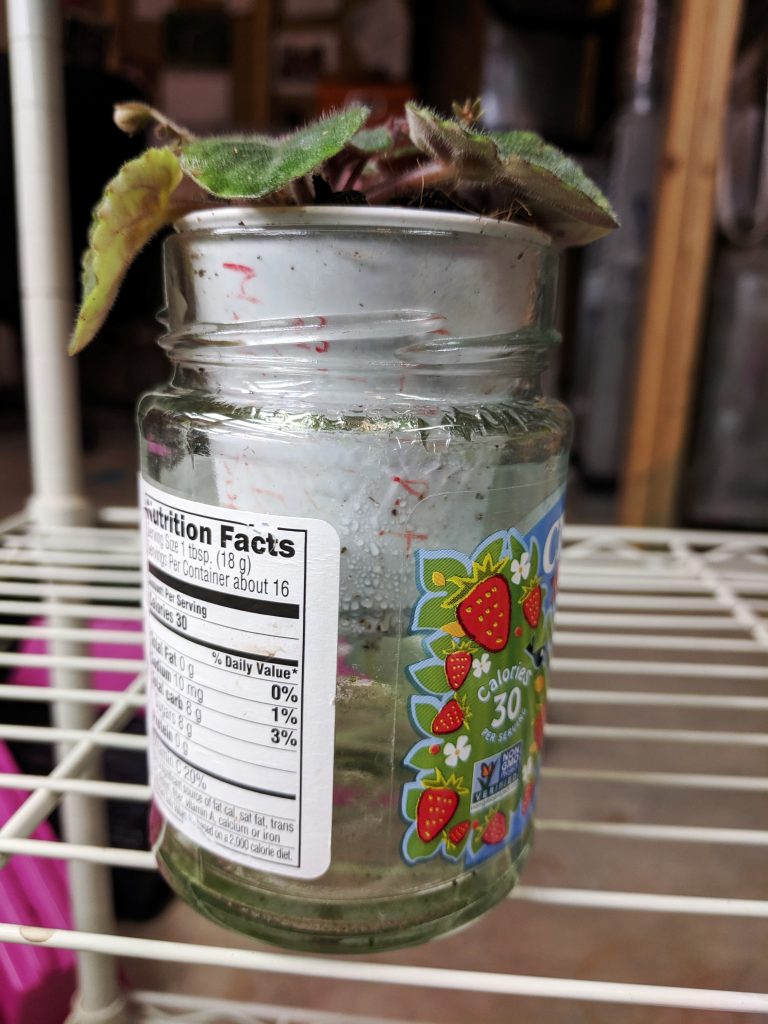
Types of reservoirs for water- wicking African Violet plants?
- Commercial reservoirs (which are placed under the African Violet pots) are available for the wicks to rest in and absorb water.
- The cheaper way is to use a plastic container, such as a small Ziploc container with two holes punched in the lid. One hole for the plant wick to go through the lid and the other hole for air ventilation.
- The end of the wick threaded through the lid is then extended down inside the plastic container filled with water and the violet with the lid is used to snap-close the container.
- The cut out hole for air ventilation can also be used to fill water in the container with a pipette and without opening the lid.
- Butter/margarine/yogurt containers can also be used as reservoirs.
- A drill bit (size 3/16”) can be used to make holes in plastic containers.
- Glass containers such as baby food jars or the bell canning jars can also be used.
- Sandwich bags or small plastic bags can be placed inside the plastic/glass jars and when algae forms or they get dirty; they can be easily removed and replaced.
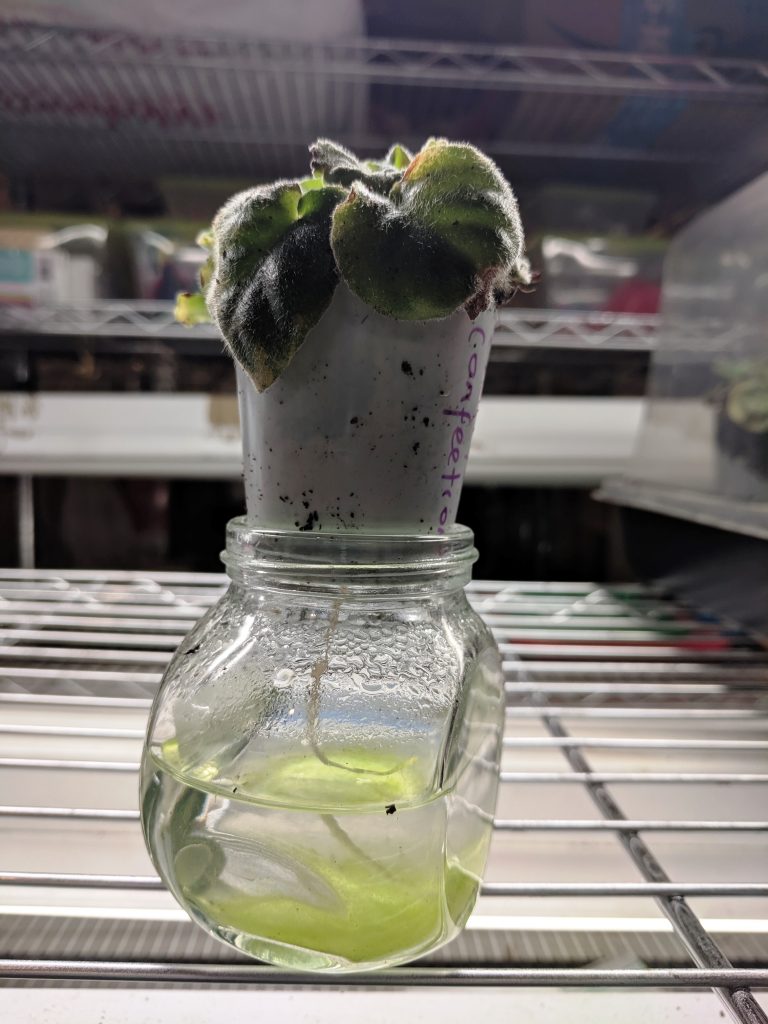
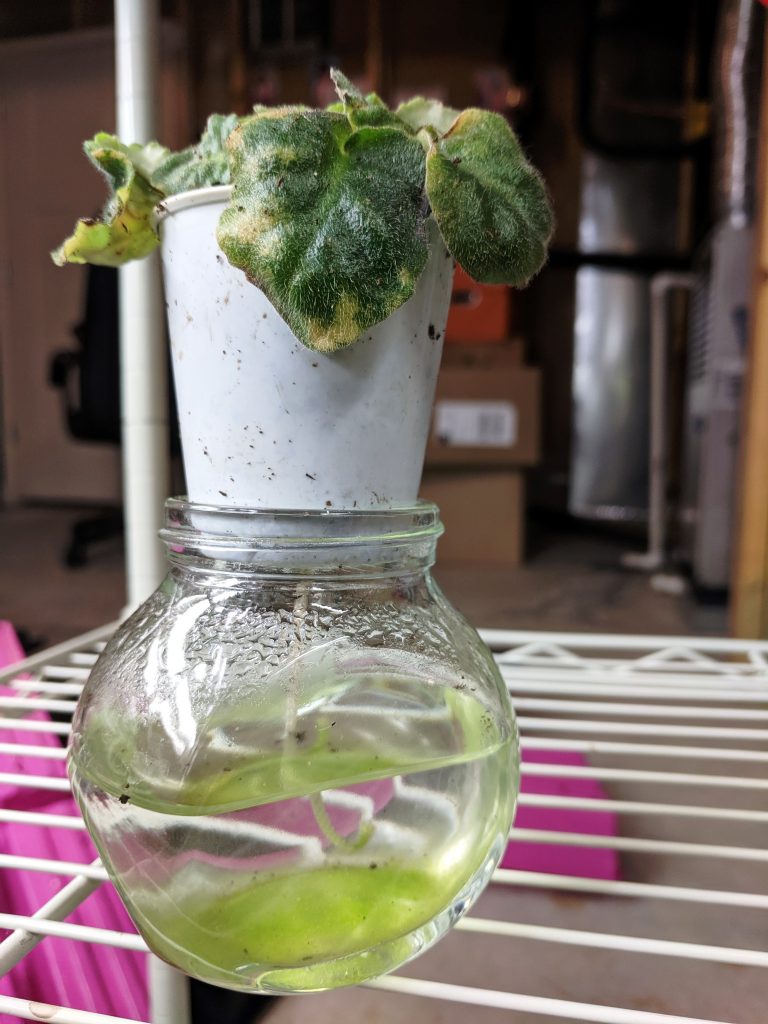
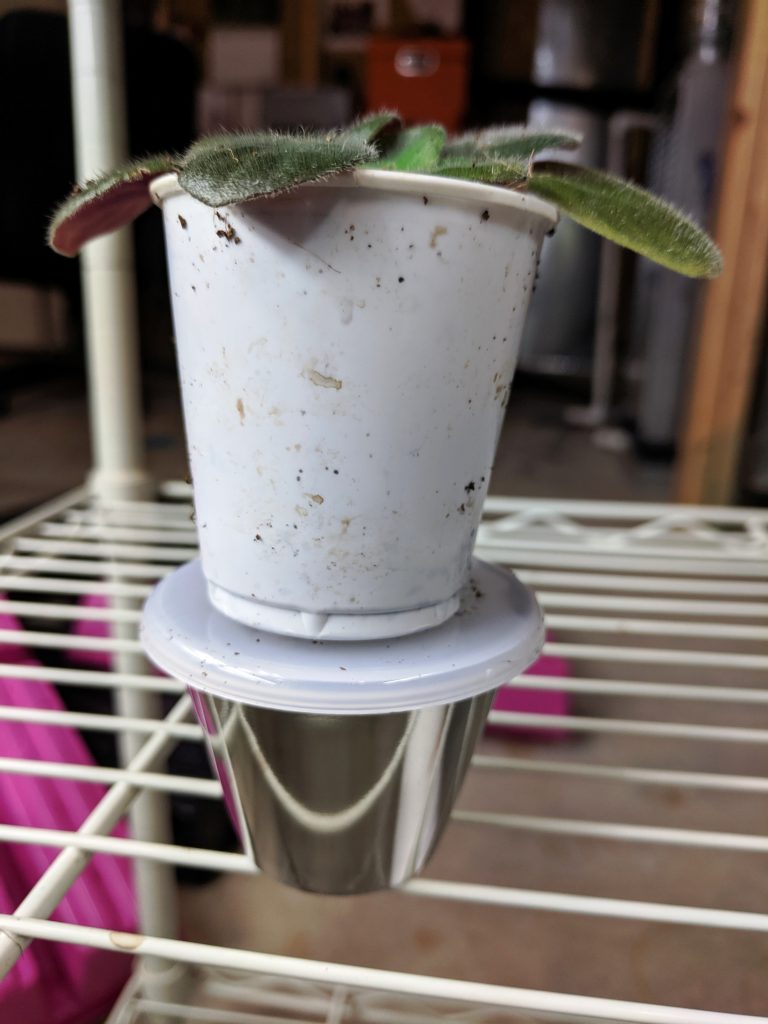
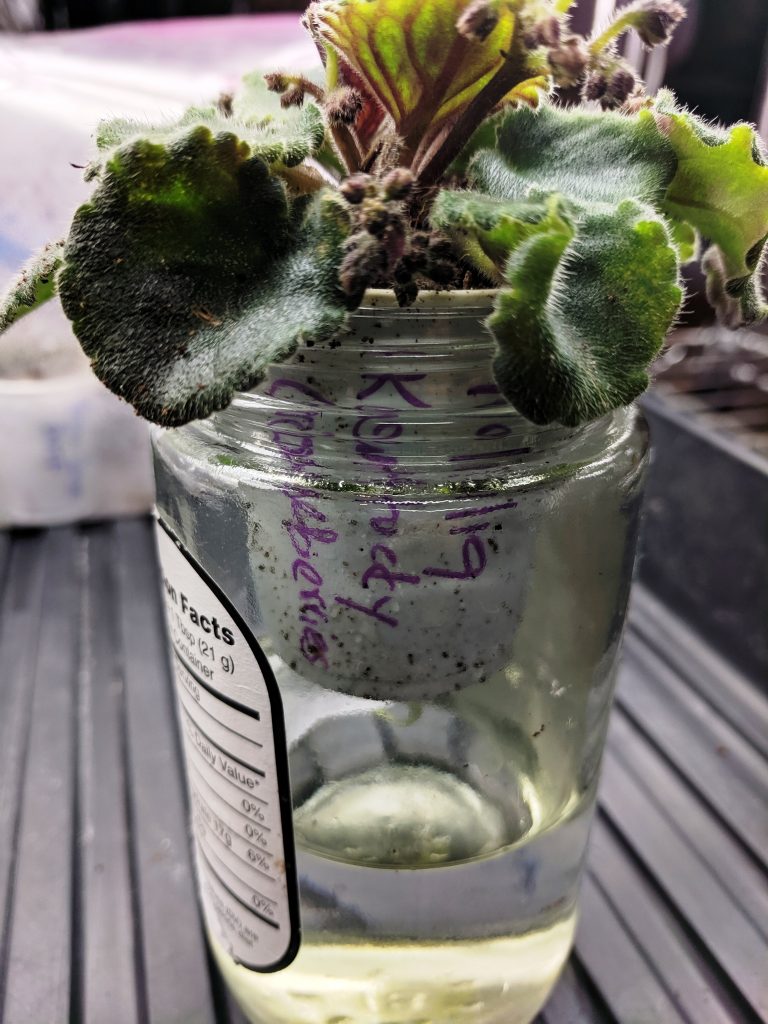
How to add fertilizer to water- wicked African Violet plants?
- One of the great advantages of water wicking African Violet plants is that fertilizer can be added to the reservoir water thus maintaining a constant feed of fertilizer.
- The fertilizer should be added at a diluted concentration, at either a half or quarter strength depending upon the size of the reservoir. At half the strength of the recommended amount. For e.g. if it says to add ½ a tsp to a gallon of water, then add 1/4th tsp instead.
- The reduced strength of fertilizer is added to prevent the reservoir water from becoming too concentrated over time with fertilizer.
- It is recommended to top water the plants every 6-8 weeks to flush out any fertilizer salts that may have accumulated within the pot.
- During this time, do not re-fill the reservoir or water the plant for 4-5days, allowing the top soil to dry. Then wash/clean the reservoir and re-fill with fresh room temperature water. This can be done each time the reservoir needs re-filling with fresh water.
- If you notice algae in the water, that is fine, it does not cause any harm apart from the unsightly look. Algae can be avoided by added an algaecide (Physan 20) to the water at the same diluted strength of ¼-1/8th tsp.
Physan20 and fertilizer recommendations below:
When to top water wicked African Violet plants?
- As mentioned above, once every 6-8 weeks it is best to top water the water wicked African violet plants to flush out fertilizer salts from the root system.
- Allow the reservoir to dry out of water and then over a period of 3-4 days allow the pot soil to become dry also.
- Then continue wick watering by adding fresh room temperature water to the reservoir. Fertilizer and an algaecide can also be added to the reservoir at this time.
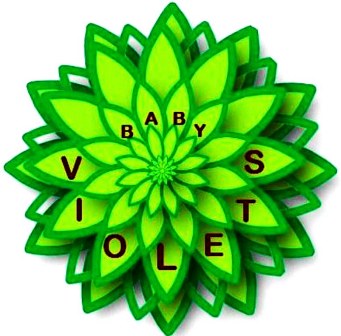
*Our Affiliate Programs: We are a participant in the Amazon Services LLC Associates Program, an affiliate advertising program designed to provide a means for us to earn fees by linking to Amazon.com and affiliated sites.
Though we do link to many items on Amazon out of convenience to our readers, we do also participate in other affiliate programs that also pay us a commission for any purchases you might make through our links (at no additional cost to you!).

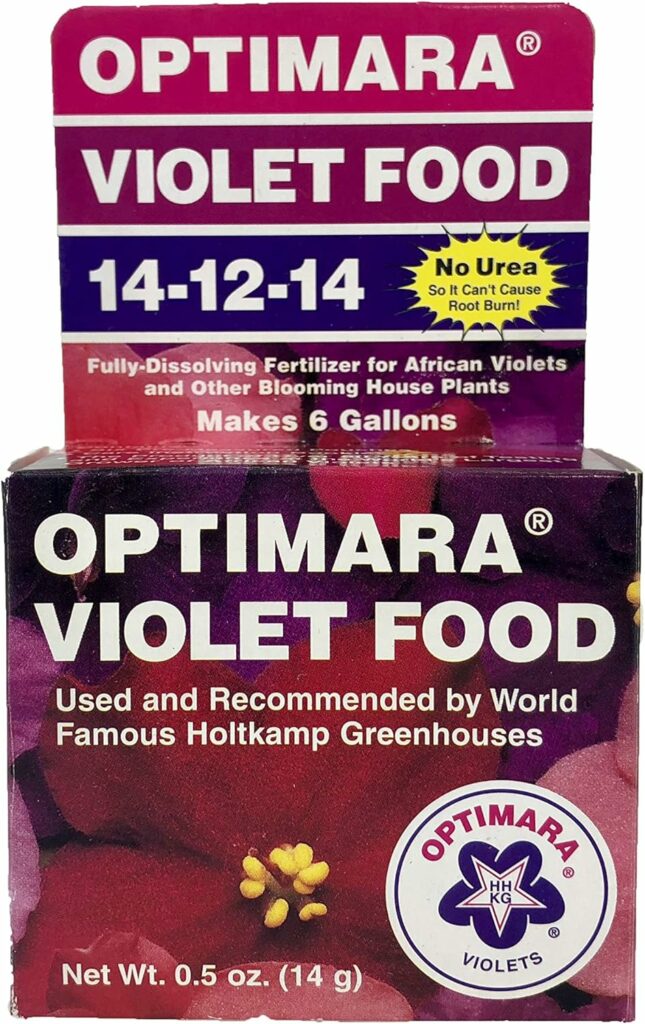

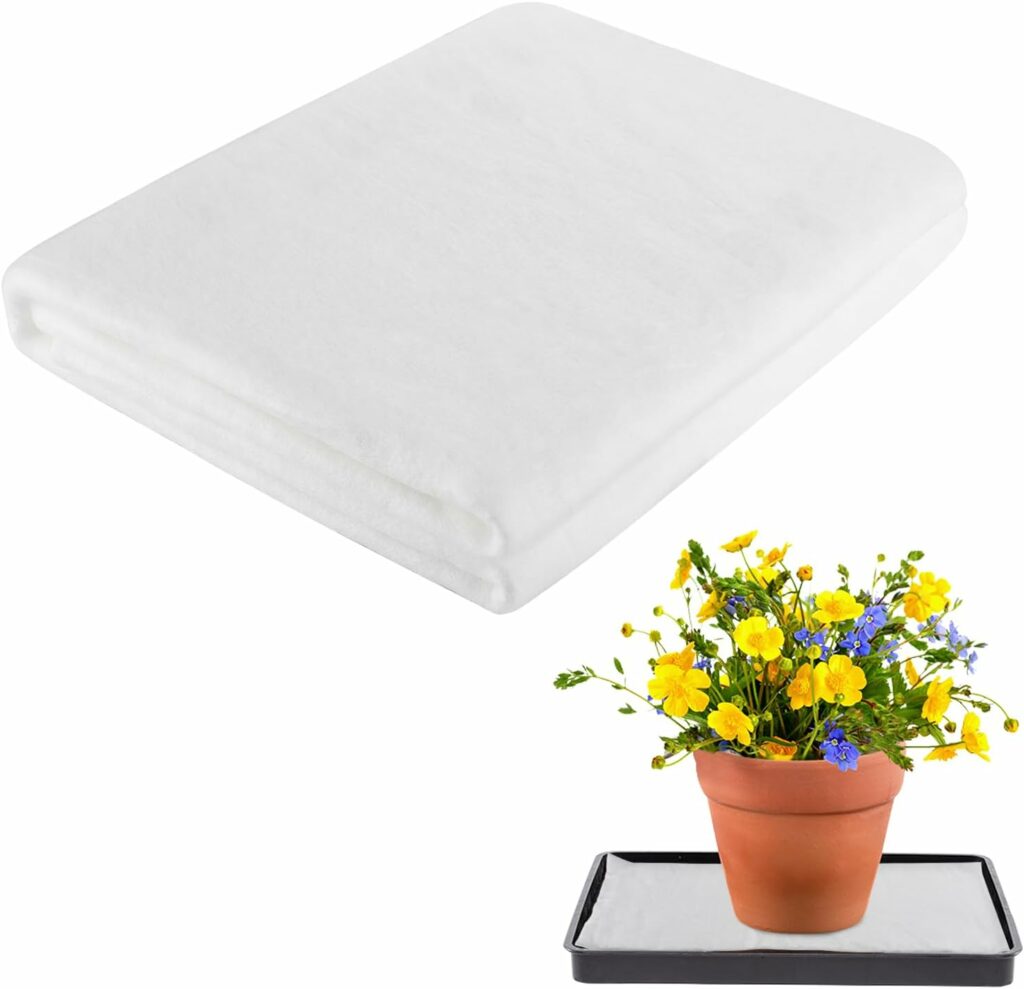
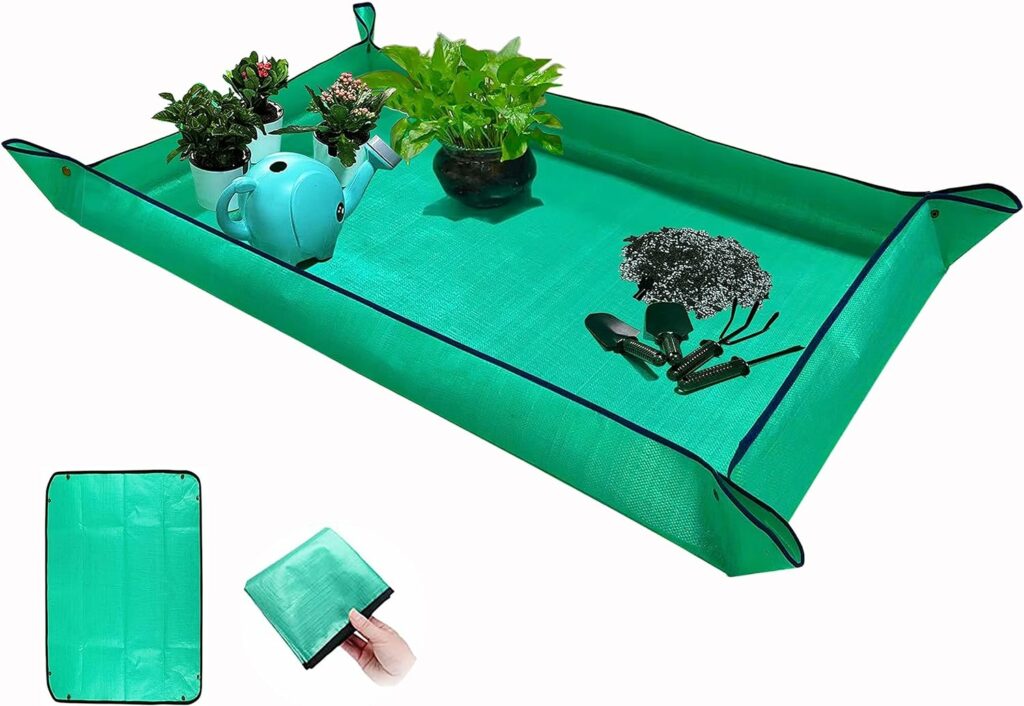
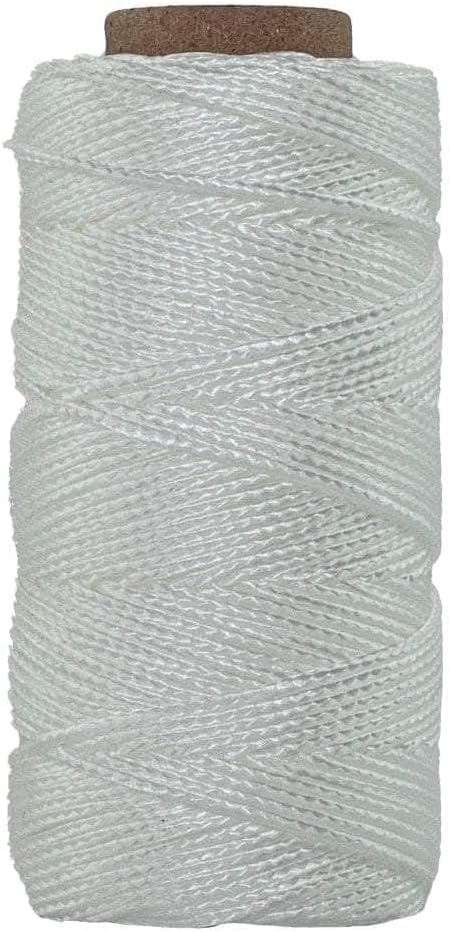
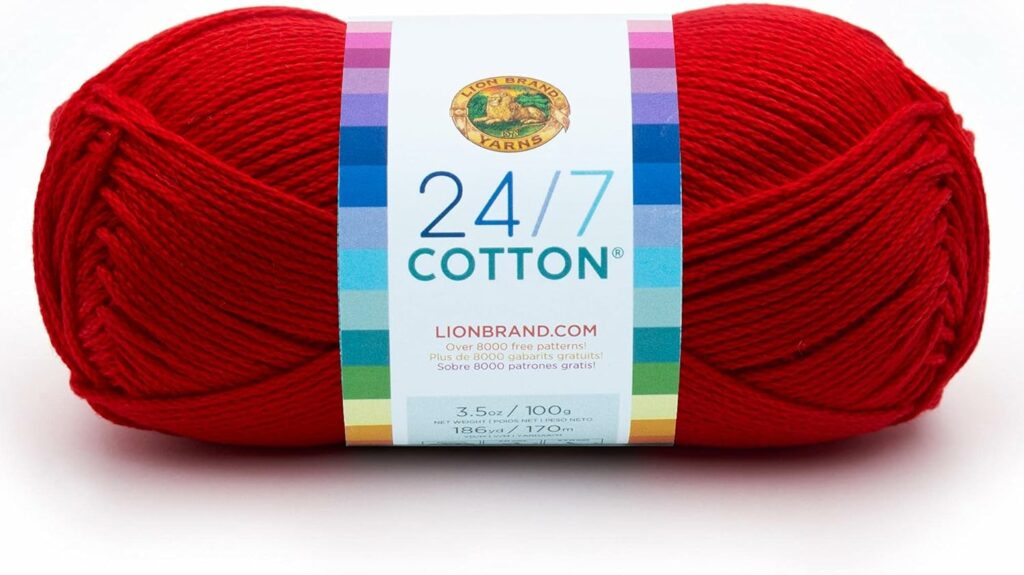


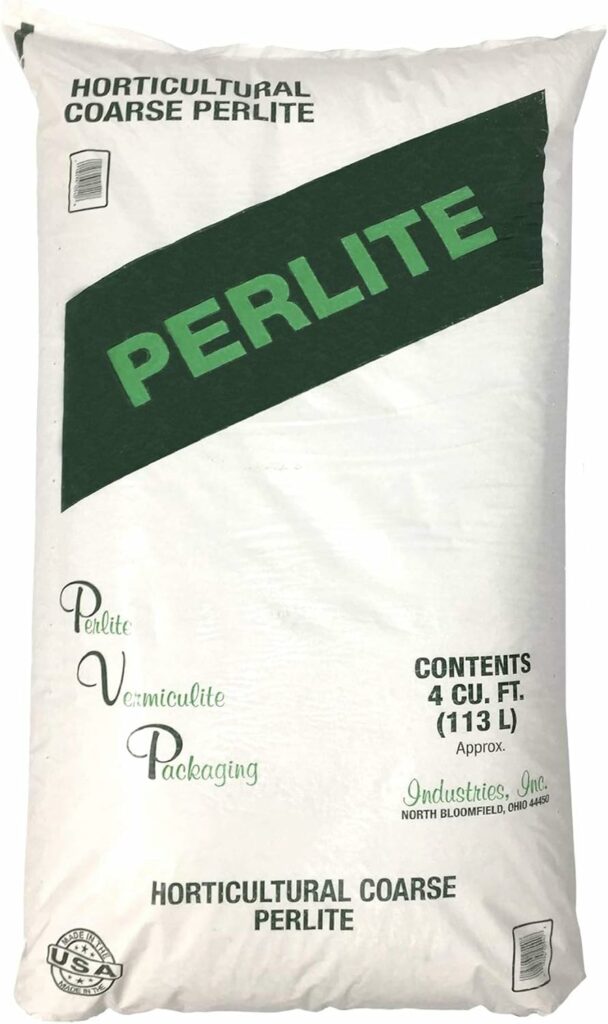
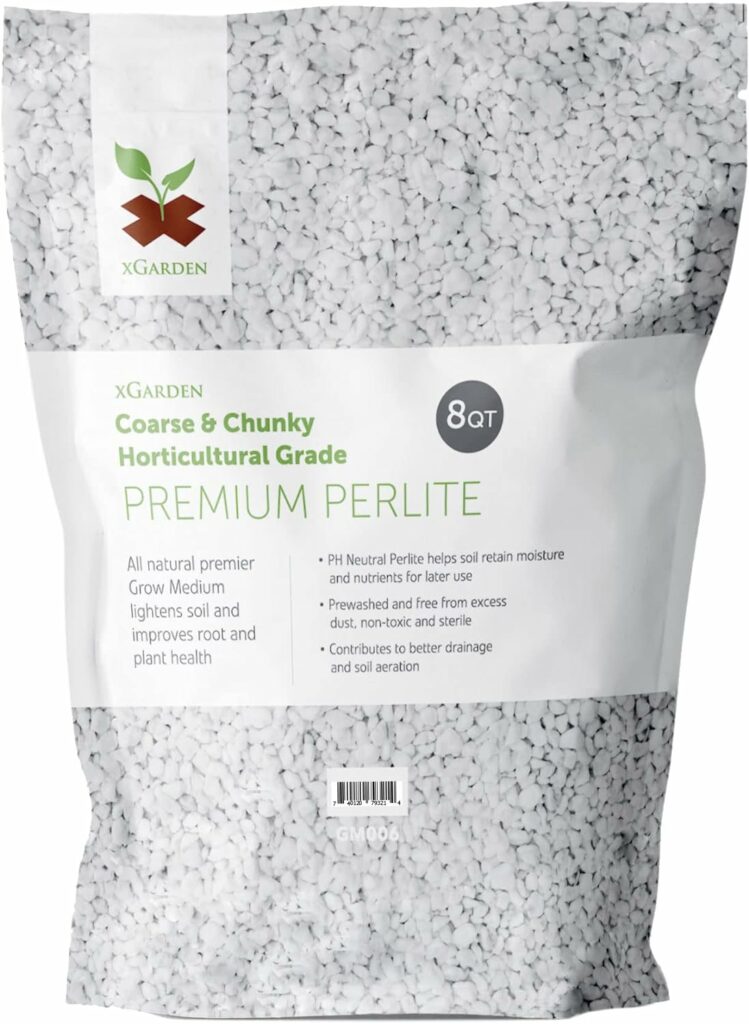
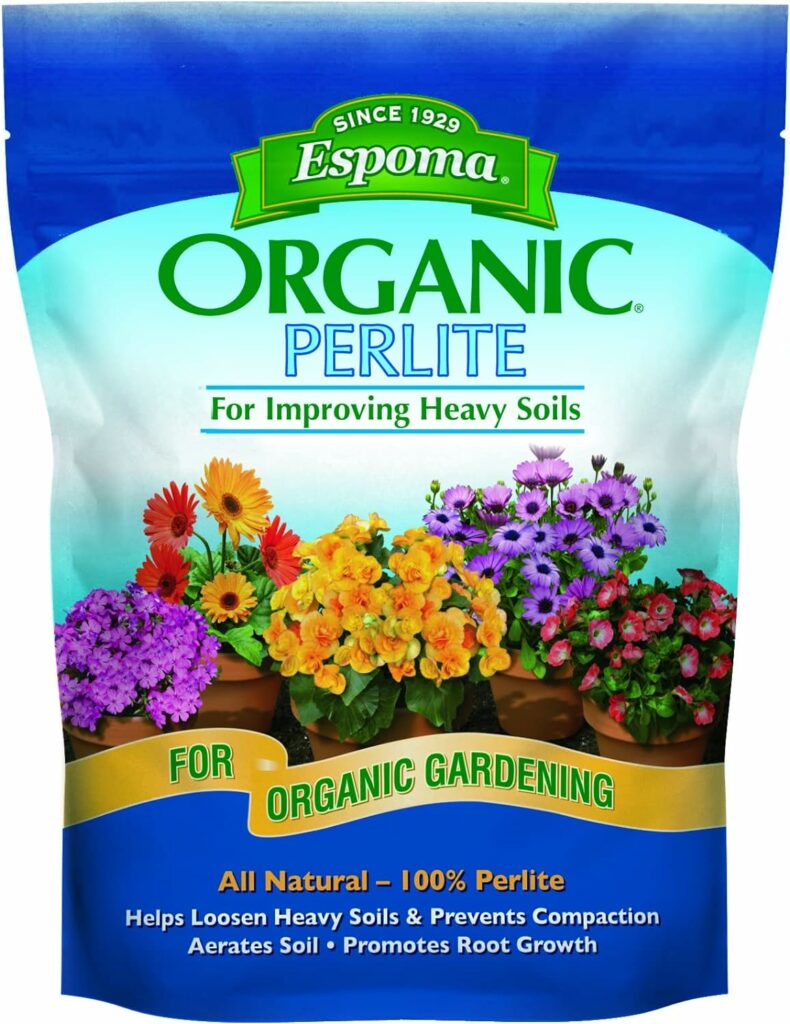
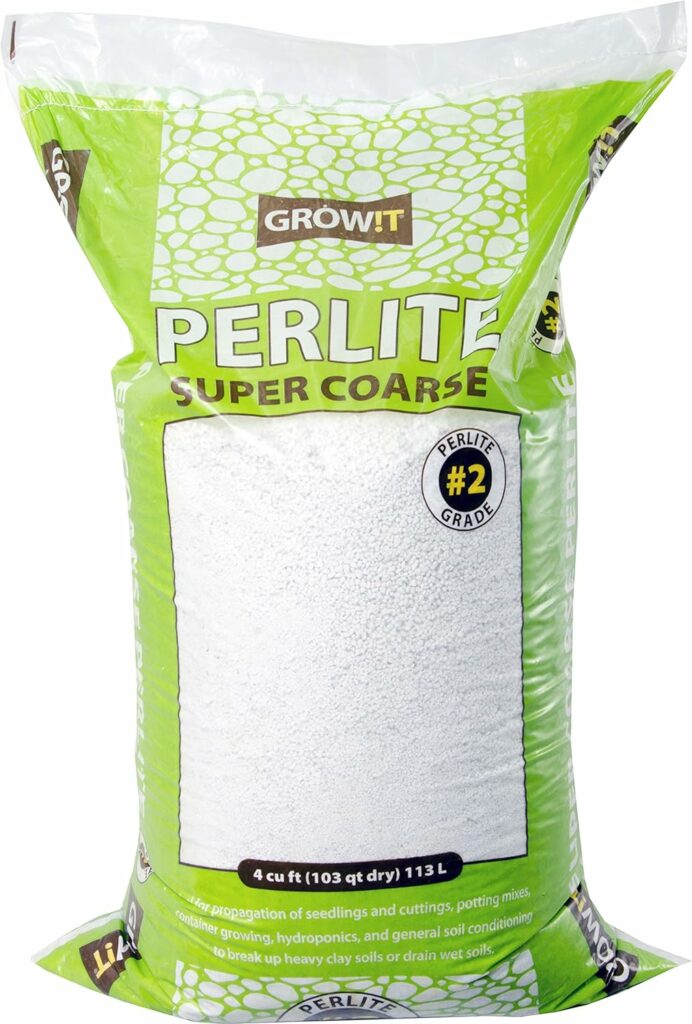
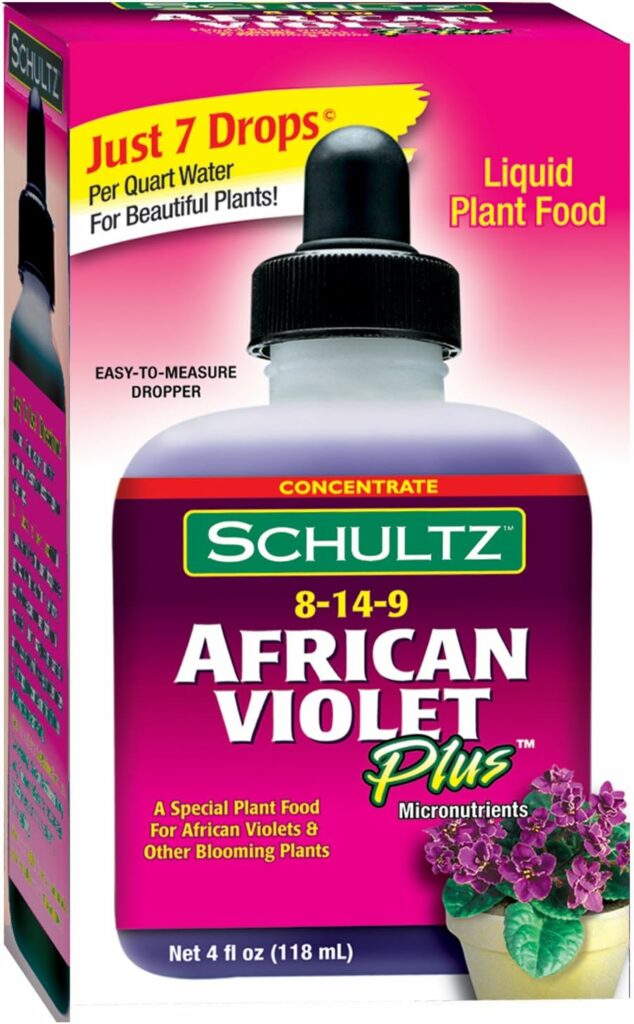
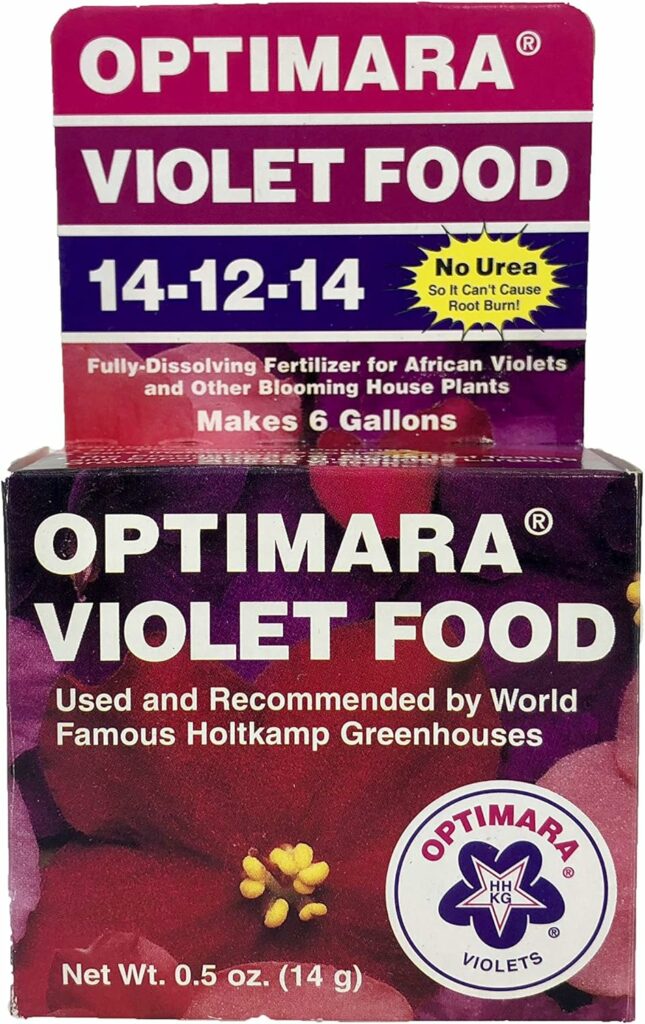

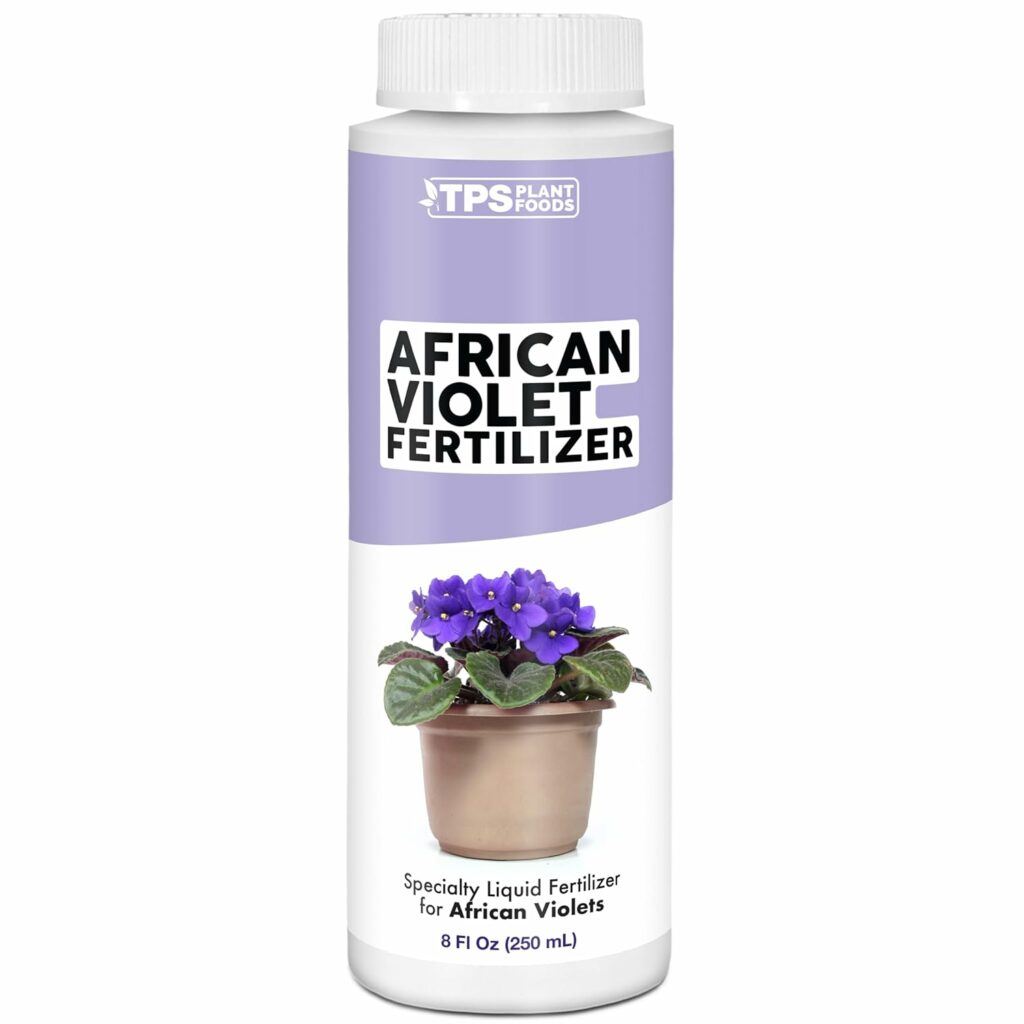
I guess I am not smart enough to understand this recipe. I need to know 1 cup of this and 2 cups of that until the requirements are filled. Can you do this for me?
Mr. I don’t get it :0)
Potting Mix / Soil to encourage wick watering in African Violet plants?
For wick watering African Violet plants, the potting mix / soil should be light and airy.
This includes either a soilless mix of only vermiculite/perlite or a light soil mix of at least 50%-75% vermiculite or perlite and 50%-25% peat moss.
Hello Clyde,
50:50 means, 1 cup of peat moss and 1 cup of perlite, mixed together in equal amounts. 75% – 25% means one and half cup perlite with half cup peat moss. Hope this helps. I will go ahead and add in the cups amount in the article, it might be useful for other people and easier to understand.
BV
Do they sit on the reservoir all the time?
Hello Claudia,
thank you for your question. Yes, they do sit on the reservoir all the time. An exception, would be if when you are adding water to reservoir, cleaning the reservoir or flushing out any fertilizer salts from the pot soil. Hope this helps,
regards,
BV
Thanks for the info…my African violets need transplanting so I’ll try this on my 2 small ones!
I have a violet plant that seems to have very shallow roots. The top is beautiful, but it always feels like it could pop out of the dirt or break away at any moment, unstable…What can I do to strengthen the roots?
Thank you Jan
Hello,
thank you for your question. If you have not recently repotted the plant, you move it to a smaller pot with a lighter mix (containing peat moss and coarse perlite). Then place the plant in a closed plastic baggie. Keep in baggie for a month, open the bag over the next few weeks little by little, until the whole bag is open. Then place the plant back outside. Over this period of time, you should see new growth from the crown and the plant should have stabilized more in the soil too. You can fertilize the plant once you open the bag after a month. Dont water the plant while its in the baggie, the moisture collected should be enough. Unless the soil seems dry to touch and pot feels lightweight, then water only a little. If the soil seems soaking wet and really moist when plant is in the bag, then open up the bag for a few hours, allow the condensation to dry or wipe the extra moisture inside the bag with a napkin and reseal close the bag. Hope this helps,
regards,
BV
Thank you for this information. I’m just embarking on a wick watering adventure for most of my houseplants.
I do have questions about fertilizing, not my strong suit in any situation. Is the water in the reservoir always 1/4-1/2 strength “fertilizer water?” Do you use fertilized water when replenishing the reservoir? What, if any, NPK fertilizer balance is best?
Thank you!
Hello Charlotte,
thank you for your question. If you are planning to continuously feed the plants through wick watering, then I would suggest 1/8th tsp of fertilizer per gallon. The less the better. I usually feed once a month, so will replenish the reservoirs with fresh water with fertilizer (1/4tsp fertilizer per gallon). I will wait for water to evaporate or get less, after a few weeks, will replenish with plain fresh water. Regular balanced fertilizer should be fine even for wicked African Violets. No need to use anything special. I recently used optimara fertilizer (12-14-12), and it works quite well. Hope this helps, BV
Thank you for the information. I feel a lot more confident now.
Your welcome,
BV
I have recently set up all my violets on wick watering with a sterile soil-less mix that is half perlite. They are growing faster and seem happy but I’m developing a pale yellow fungus growth on the surface of the soil. So far there aren’t any negative effects on the plants but I hate the look of it. Any ideas?
Hello Kim,
Thank you for your question. Glad to hear your plants are doing well. The yellowing, may be the perlite. Sometimes when perlite becomes old, it turns yellow and starts to break down. Also, if you are top fertilizing, it may also be fertilizer build up. If its bothering you, can scrape off the top a little (1″) and top off with fresh soil. As long as its not spreading to other plants, you should be fine. If its over 6 months since you re-potted the soil, maybe its time for re-potting. Sometimes, older outer leaves will fall on the soil, become mushy and start to mix with, this organic matter can turn yellow too. Hope this helps, regards, BV
#18 Mason for wicking is that too thick or would absorb too much water? I never know what size mason I should use for wicking my African violet trailers. I have number eight and I don’t think that’s enough.. can you help.
Thank you..
Nancy
Hello Nancy,
Yes #18 mason twine should work fine. I have used that and it works for me. I do not separate the strands, though for minis, I have heard that some growers do separate the strands. Home Depot, has them at a reasonable price, it lasts me a year, homedepot.sjv.io/yXNdG . Yes, I agree, #8 might be too thin, though not sure, as I haven’t used it. BV
WHY DOES THE WICK NEED TO BE OUT OF THE TOP OF THE POT. I JUST SET MY PLANTS UP WITH WICKS. I LAID THE WICK IN A CIRCLE AT THE BASE OF THE ROOTS.
Hello,
thank you for your message. It is personal preference to leave the wick out from the top, you dont have to. I usually do it that way, no particular reason. As you mentioned, as long as the wick comes out from the bottom of the pot, its fine that way too. BV
Can you convert #18 Mason line into a diameter either inch or metric. Thanks
Absolutely, I can add this information. The diameter of #18 mason twine is 1/16th of an inch (0.0625inch ) or 1.58mm. Regards, BV
Some of my wick watering on my African violets start to grow roots start to grow roots down the wick. What should I do.They do not seem to be rotting. Should I cut them or let them be.
Hello MaryAnn,
thank you for your question. For now, you can let them be, as long as they look healthy. If it is bothering you or when you get a chance, you can gently separate the roots from the wick and cut them off, it will not damage your African Violet in any way. If your plant is older, that is normal for the roots to spread out on the wick. If you havent re-potted in the last 6 months, you can consider to re-pot once size up and put all those roots back into the soil/pot. Hope this helps, BV
Is there a soil mix for self watering pots that can use for my african violet plants?
Hello Jan,
thank you for your question. For self watering pots, its best to use a light and porous mix, which allows for water drainage and doesnt clog up the soil. Make sure your soil mix, has at least 50% perlite, it can have more. Perlite would work as a better additive then vermiculite in self watering pots. So an equal mix of peat moss to perlite should work well. Hope this helps, BV
My violets are in a commercial potting mix designed specifically for African violets and in wicked commercial reservoir pots however over time the soil gets water logged and I lose my violets to rot. Any suggestions?Should I leave the reservoir to dry out for a few days once empty before refilling?
Hello Cathie,
thank you for your question. Does your soil have an equal ratio of peat moss/soil to perlite? It could be the soil is too dense, not light (which can be made light by adding coarse perlite), that’s why the soil is retaining water and staying wet. Though you mentioned you are using a soil mix designed for African Violets so it should have the required perlite amount and should be light weight. Yes you can let the reservoirs dry out every few days before refilling. You could alternatively, let the soil dry out from the top about an inch too, before adding water to the reservoir. Rotting can also occur, if the roots ball/roots are less in volume/small rootball in size/less roots and the pot is too big. If the pot is too big, all that soil in the pot will retain too much water and there are not enough roots to absorb all this water, so it just sits in the soil. You can try a step by step approach. First, check your type of soil, then allow the top of soil to dry out slightly, then allow the reservoir to dry out. If this doesnt help, then check your rootball size/roots and consider if the pot is too big, you can repot to a smaller pot when the time comes (every 4-6 months). Hope this helps, regards, BV
I got interested in using the wicking system at the beginning of September. I watched videos, bought 2″ pots, a grow light and started 20 leaves off my three different African violet plants on 9/9. I am using a soil mixture of 1/3 peat moss, 1/3 perlite, and 1/3 vermiculite. I was so excited to see new babies coming up after about two months. I only lost one starter leaf out of the 20! My question is: I am having a problem with a light mold that is forming on the top of my soil mixture. It seems to grow especially on the Perlite. What can I do about this? It doesn’t seem to be harming the plant, but looks awful.
My wicking material is ORIMERC 1/6 Inch Self Watering Wick Cord. Is it my soil mixture or the wicking material wicking to much water?
Hello Linda, thank you for your question. Are your plants under lights in humidity domes, the mold maybe due to increase in humidity. If they are outside under natural light, it may be that the soil is too wet, or overwatered. The cold air outside, can make the soil cold too, that can cause the mold too. For the most part, it wont damage the plant, as you said it just looks weird. For now, you can let the soil dry out, then remove the top layer of mold (1″ inch). In winter, you can let the soil dry out a little, before you add water to your wicking container. Your soil mix seems fine, the ratios should be enough to allow drainage. Next time when you repot, you can add a thin layer of coarse perlite at the bottom of your pot, this will help with drainage. If this does not help and the mold still bothers you, I would recommend a fungicide, like Physan20, https://amzn.to/2R7NUGc. I have not personally used it, but have heard others use it on capillary matting to remove the green algae like coating. Hope this helps. BV
When I lift the pots to fill the reservoir there is water droplets on the outside of the pot. Is that OK?
Hello Everett, thank you for your question. Yes its fine if there are water droplets on the outside of the pot, it sounds like could be condensation, caused by increased humidity.
regards,
BV
I tried a wick type self watering system for my African violet and the soil became soaked and the violet died or is dying. How much water should be in the reservoir? It seems like the soil sucked up all the water at once, thus drowning the violet.
Hi Jean,
It sounds like your wick is too thick and is absorbing too much water. You can split the wick in half, if possible, or replace the wick with a thinner wick. For now, remove the plant from the wick system, allow to air dry and let the soil become damp. You dont want the soil bone dry, but just damp enough. The amount of water depends on the size of the reservoir. The water shouldnt touch the bottom of your main pot, your main pot should sit above the water reservoir, not in it. You can do a simple experiment to figure out the water amount, once your plant soil is dry, measure 1/2 cup of water and add to plant from the top, wait till water comes out of the bottom drainage holes, if it doesnt, measure another 1/2 cup and add. Keep a note of the total amount of water added to keep the soil moist. This can be the amount you fill in the reservoir, though make sure the water level , sits below the main pot in the reservoir. Also you can let the soil dry out slightly, before adding fresh water again to the reservoir. Hope this helps, regards, BV
Hi I will like to know why some of my violets won’t do good with wick, the leaves look droopy.
Thank you
Hello Yanet,
thank you for your question. There are a number of reasons the wick doesnt work. It could be your soil mix is too heavy, need to use a lighter soil mix with perlite added to it. A soil mix with half peat moss and perlite will work. Perlite similar to this, https://amzn.to/2NaGXVq
Another reason could be the number of wicks, if your plant/pot size is large, you may need two wicks. The best material to use is nylon twine (mason twine), I have had better results with it. Your wick needs to be wet before you put it into the pot and wicking container. If its dry it wont be able to absorb water. Give it some time, if your plants are small, it will take them time to get used to the wick. For me it takes 2-3 months, before my African Violets get used to the wick. Hope this helps, BV
Good Morning, great site! Using #18 mason twine, how many wicks per plant. My violets range from 4″ to 13″ across the leaves?
I just bought a African Violet in a 4 inch pot with wick system. It probably holds 1 oz. of water. If I mix a gallon of water with fertilizer, how long is it good for? Also, I gather from what I am reading that I need to repot every 6 months. Am I putting the Violet in a bigger pot or just using new potting mix in the same pot? Thank you for the help!
Hello: How many wicks should a violet need that is about 10″ diameter across the leaves, in a 4″ pot. The soil mix is 50/50 perlite & peat moss. The roots are growing all the way done the single wick to the bottom of the reservoir.
Hello Everett,
thank you for your kind words! If you are using a #18 mason twine, for a 4″ – 6″ violet, 1 wick per pot is enough. For a larger plant 13″, I would recommend 2 wicks per pot. If you are unsure about how many wicks, can do a little observation experiment. Put one wick in a pot, observe the rate at which the soil is moistened and how long it takes for the reservoir to be empty. If its too slow with one, can add one more wick. See how that goes. If the soil becomes too wet with two wicks, can lighten the soil mix, by adding perlite, that can help with water drainage. Hope this helps,
regards,
BV
Hello Everett,
If you are using a #18 mason twine, I would only use 1 wick. I have a similar size violet in a 3″ pot and use one wick. For a 4″ pot, I would assume one wick would work. If the roots are growing all the way down the single wick, that’s normal and fine, nothing to worry about. I have a few that do that, havent seen any long term negative changes in the plant. If the root ball inside the plant soil, starts to fill the pot and its full of roots, then its time to re-pot. Otherwise, roots down the wick shouldnt be an issue. Hope this helps,
regards,
BV
regards,
BV
Hello Cheryl,
Your fertilizer water can last for a month. Its best to use within a week, but I have kept for a month. Make sure to store in a dark place and at room temperature. Yes, re-potting every 6 months is a general rule. If your plant looks healthy and is blooming, you can extend that to 6-10 months. Many times, I forget to re-pot, will check the date and realize its been close to 8 months, I will then go ahead and re-pot. You would be re-potting with fresh soil in a same sized pot ( a fresh clean one ). Once you take your plant out from the pot, if the roots are completely filling the pot, the root ball is large and roots are wrapping around each other, then yes, I would recommend potting one size up, other wise same size pot is fine. Hope this helps,
regards,
BV
Thank You so much. My reservoirs are looking like a jungle.
Question: the best method i have found to propagate leaves is in water. but it seems counterproductive to then place the leaf and new roots in dry soil as many sites suggest. why can’t i wick water them at this point
Hello,
thank you for your question. After you have propagated the leaves in water. You can transfer them to fresh soil in a pot and yes then wick water them, that should work fine. However, if you leave your leaf in water the babies will grow out, but they wont last long, eventually they will need to be transferred to a soil mix. Yes, you can wick water the leaf, till the babies are large enough to be transferred. However, I am not sure how the babies would react when directly being transferred from water to soil mix, they may experience a transplant shock and not survive. If the leaf/babies are transferred to a soil mix first, that gives the baby plantlets a chance to get used to the soil mix, to spread its roots in the soil mix and then they will grow more readily into soil when transferred. Hope this helps, BV
Thank you for your patience and understanding with your readers! When your violets are not bagged, what do you keep the humidity and temperature of your growing area at?
Hello Chris,
thank you for your question and your kind encouragement. In my growing area, current low temperatures are at 73F and high at 77F. The humidity is at 56% (low) and 67% (high). My violets are comfortable in this environment. In winter the temps will drop to low 63F and high 68F (they are ok, not too bad). The humidity can drop to 48% low and 53% high, if they dont look too good, I will put the trays underneath humidity domes or plants in ziploc baggies in the winter, which helps quite a bit. Hope this is useful! regards, BV
I have always laid the top of my wick under the plant roots. When reading these comments, something occurred to me. If it is accessible at the top, a new piece of wick can be tied on the bottom and pulled through the pot from the top. Sound doable?
Hello Bonnie, thank you for your question. In theory, yes it does sound doable. I think it should work fine, though I have not personally tried this :). Regards, BV
Help!!!Repotted All my violets in Nov. to wick watering and have lost half to root rot. What am i doing wrong…Possibly potted plant to low in pot. How would I know? Soil is 1/3 Vermiculite,1/3 Perlite and 1/3 African Violet soil.
Hello Allison, thank you for your question. Your soil does not seem to be too dense, you have a good mixture of vermiculite/perlite to soil, so that shouldnt be the issues. Is the wick too thick? Did the plants have a well developed root system? If they are baby plants and they dont have a well developed root system, wicking makes them absorb too much water and they cant handle the wick system. Sometimes its best to wait till the plants become mature and develop good enough roots so they can handle wicking. I am not sure if potting too low in the pot, can lead to root rot, I havent had this experience, so cannot say for certain. When you re-potted did you add a thin layer of perlite in the pot, before you added your soil mix, the thin layer of perlite at the bottom can help with water drainage and prevent clogging of water. Sorry couldnt be of much help, not sure why the root rot occurred. regards, BV
I love all the information you provide! Very easy to understand…but…I’m getting ready to start with watering via wick with Optimara.
I have the packages that you mix with a gallon of water and have done so. How would I go about using this application in a small 3 in wicking pot? Tia! Holly 😊
Hello Holly, thank you for your question and kind words. Do you have your plant pot sitting in another outer container? You can add the fertilizer mixed water solution to this outer container. The wick will soak up the water as required. If you have it in a self watering wicking pot, then you can water as you normally would, just add the fertilizer water to the opening in the self watering container. The optimara mix is not that strong, if you have added that one packet into a gallon of water. It will be ok to use that mix, as you generally would, since the proportion you are using is quite diluted (that is, 1 packet in a gallon of water). Hope this helps, regards, BV
that wicking cord is cotton. also, it’s too thick and draws too much water. I bought the exact same product–I have no idea where I got the information to do so, but it’s bad! try a synthetic wick that’s smaller.